







TOTAL




More boats. More destinations. More programs.









TOTAL




More boats. More destinations. More programs.
Close your eyes. Feel the sea breeze and the sun on your skin. Take in the unmatched views of a pristine paradise from your private yacht – accompanied by friends and family. It’s not a dream. It’s Dream Yacht.
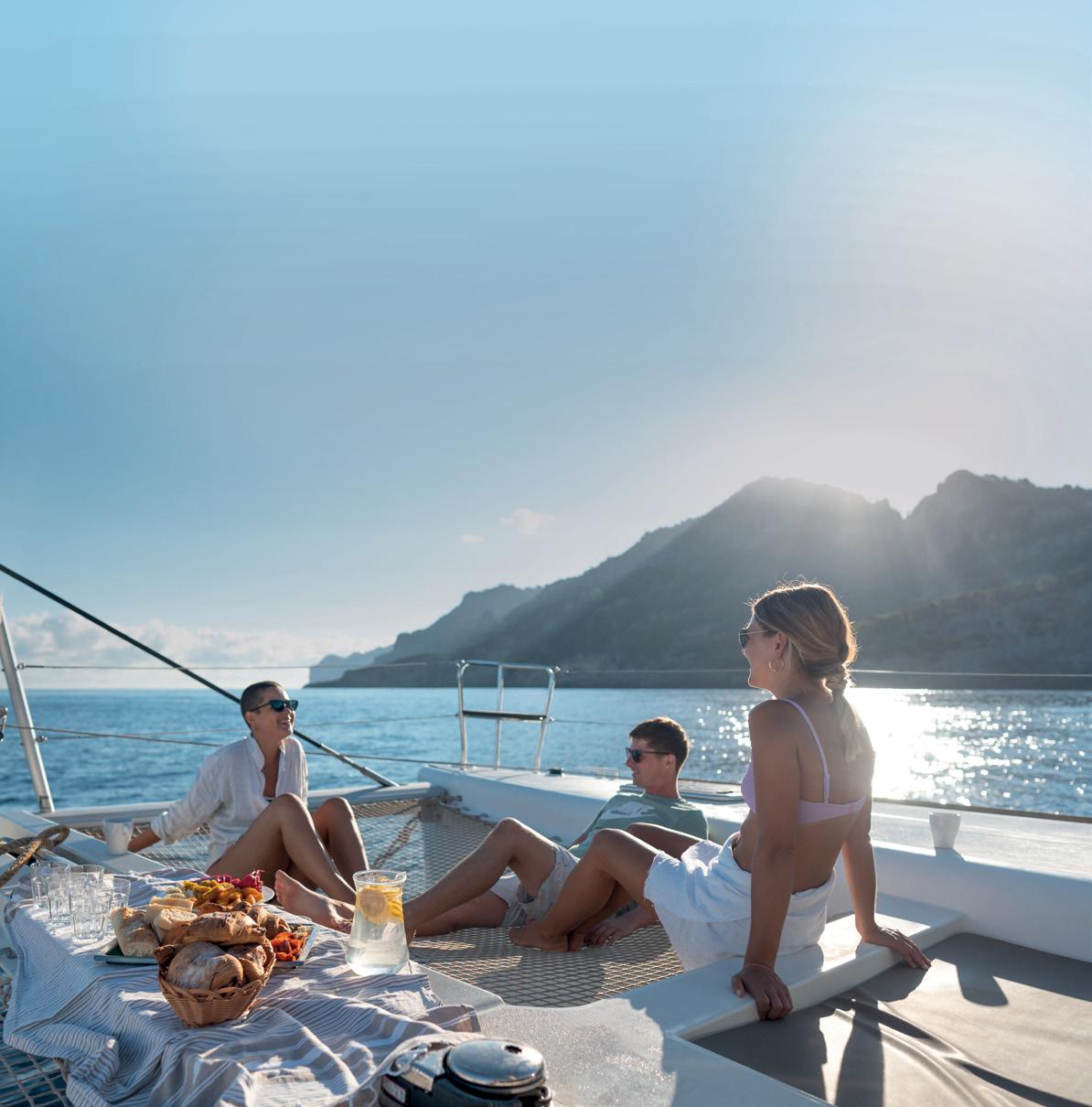
Sailing around the world and visiting new places each time is a great privilege, and a Dream Yacht charter program adds ease and security. From the feeling of arriving to a well-prepared yacht to the freedom of choosing from 50 of the world’s most stunning destinations, you can experience the world in a way that few ever will.
With a wide range of yachts from the world’s leading manufacturers and 8 flexible ownership programs, no one can match our range of ownership solutions. Sail away, your way. Are you ready?
View our yacht models



















37
Where We Sail: For Matt
Rutherford, Sailing Is a Calling
For the record-breaking and award-winning voyager, sailing for the greater good remains the focus
By Greg Walkerpresented by Herrington Harbour
3 9
See the Bay: Off the Beaten Path at St. Michaels
A treasure trove of events, activities, and attractions to give sailors numerous new ways to visit and enjoy St. Michaels.
By Capt. Steven Toole41
Springtime Sailing Courses

News from area sailing school programs and ideas on how to hone your sailing skills this season.
By Beth Crabtree49
Spring DIY: How To Change Your Oil
Changing your boat engine oil only takes a few tools and a few steps and will save you a lot of money in labor.
By Kelsey Bonham5 1
Offshore Sailing Part 1: Sailing the Bermuda Triangle in December…
What Could Possibly Go Wrong?
Spoiler alert: a few things went wrong.
Story and Photos by Lou Frank
presented by us spars
72
Experienced Chesapeake racing sailors share tips on what top crew members do and don’t do.

 By Kelsey Bonham
By Kelsey Bonham
Will Keyworth took this month’s cover shot of one of the Navy teams at the 2022 Spring Race to the Lighthouses, hosted by the Naval Academy Sailing Squadron (NASS). The 2023 edition of this fun race unfolds April 29.
55 Bluewater Dreaming: USVI Home Away From Home By Cindy Wallach presented by M yacHt services
58 Charter Notes: Keeping Your Stuff Safe while on Charter By Zuzana Prochazka
60 Postcard From Sydney By Craig Ligibel
62 Cruising Club Notes: presented by yaZu yactHing
72 Racing News presented by Mount gay ruM

87 Small Boat Scene: What I Learned From the Old Man By Kim Couranz
For breaking news, photos, and videos, visit spinsheet.com

612 Third Street, Suite 3C, Annapolis, MD 21403 (410) 216-9309 spinsheet.com
PUBLISHER
Mary Iliff Ewenson, mary@spinsheet.com
A SSOCIATE PUBLISHER
Chris Charbonneau, chris@spinsheet.com
EDITOR
Molly Winans, molly@spinsheet.com
SENIOR EDITORS
Beth Crabtree, beth@spinsheet.com
Kaylie Jasinski, kaylie@spinsheet.com
COPY EDITOR
Lucy Iliff, lucy@spinsheet.com
EDITORIAL ASSISTANT
Kelsey Bonham
FOUNDING EDITOR
Dave Gendell
ADVERTISING SALES
Eric Richardson, eric@spinsheet.com
CUSTOMER SERVICE MANAGER

Brooke King, brooke@spinsheet.com
ADMINISTRATIVE AND MARkETING ASSISTANT

Beatrice M. Roderick , beatrice@spinsheet.com
ART DIRECTOR / PRODUCTION MANAGER
Zach Ditmars, zach@spinsheet.com
GRAPHIC DESIGNER / PRODUCTION ASSISTANT
Royal Snyder, royal@spinsheet.com
CONTRIBUTING WRITERS
Kim Couranz, Chelsea Co, John Herlig, Eva Hill, Pamela Tenner Kellett, Craig Ligibel, Gwen Mayes, Lin McCarthy, Steven Toole, Cindy Wallach, Ed Weglein (Historian )
CONTRIBUTING PHOTOGRAPHERS
Walter Cooper, Ben Cushwa, Mark Hergan, Will Keyworth, Ted Morgan, Al Schreitmueller, Cindy Wallach
DISTRIBUTION
Andy Aviles, Martin and Betty Casey, Gregory G. Greenwell Sr., Dave Harlock, Ron and Colleen Ogden, John and Chrissy Wathen
SpinSheet is a monthly magazine for and about Chesapeake Bay sailors. Reproduction of any part of this publication is strictly prohibited without prior consent of the officers of SpinSheet Publishing Company. SpinSheet Publishing Company accepts no responsibility for discrepancies in advertisements.
SpinSheet is available by first class subscription for $45 per year, and back issues are available for $4 each. Mail payment to SpinSheet Subscriptions, 612 Third Street, Suite 3C Annapolis, MD, 21403.
SpinSheet is distributed free of charge at more than 800 establishments along the shores Chesapeake Bay. Businesses or organizations wishing to distribute SpinSheet should contact the SpinSheet office at (410) 216-9309 or beatrice@spinsheet.com. Member Of:
© 2023 SpinSheet Publishing Company

COMFORT
The Crew Hooded Midlayer Jacket is a favorite among sailing teams around the world
(410) 990-4359
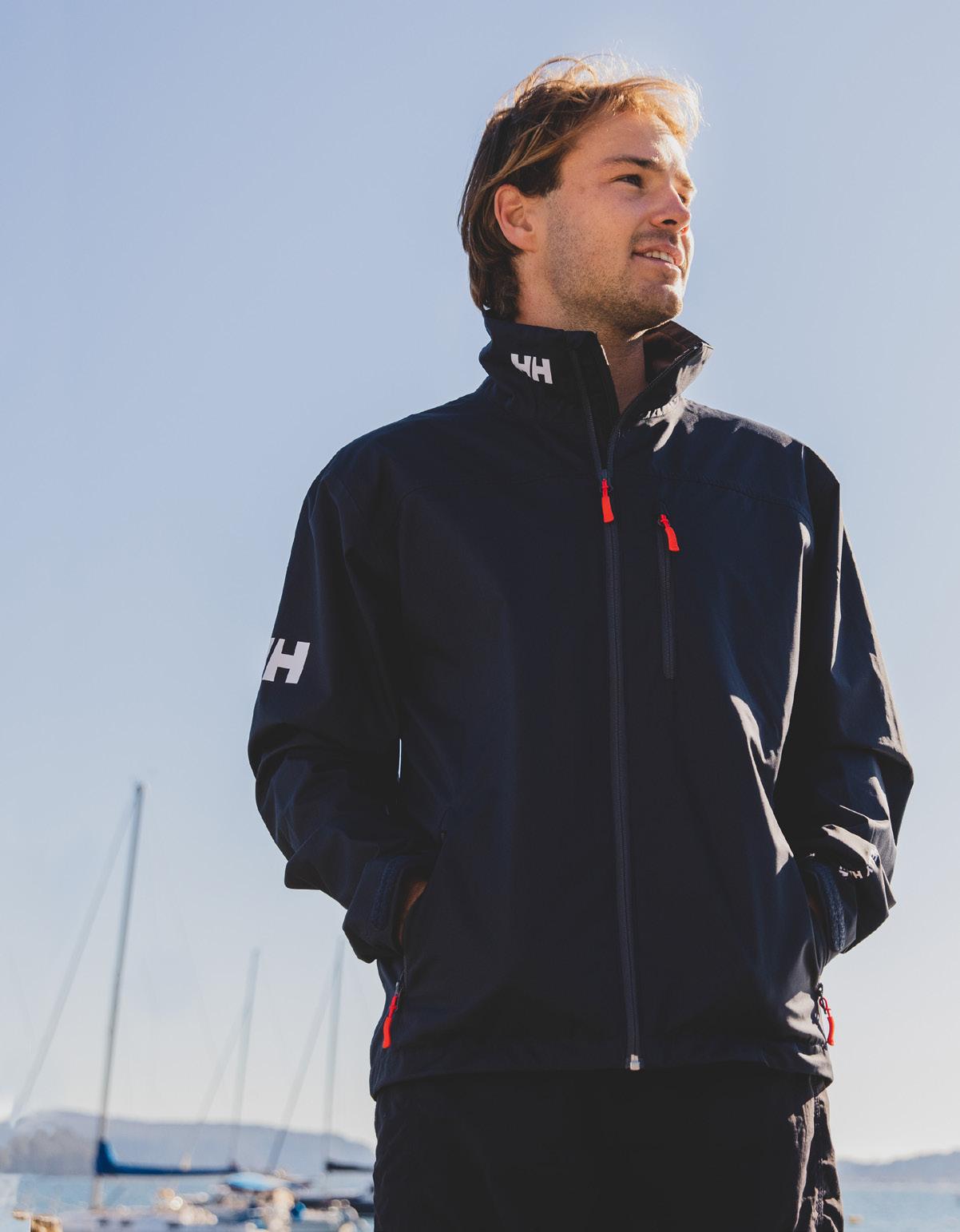

“He stayed dry… like a cat!” said Annapolis photographer Ted Morgan about Gavin O’Hare pictured here in an ILCA dinghy capsize in February.

A week before seeing this photo, I’d walked into a Saturday class at Blue Lotus Yoga Studio and rolled out my mat in one of the few spaces left in the crowded room. It happened to be next to Gavin’s mat. I’ve known Gavin and his wife Holly, also a racing sailor, for many years but had never seen him in yoga.
Yoga is not a competitive sport. Saying someone is “good” or “bad” at it goes against the grain of yoga. “It’s all practice,” my yoga instructors would say. “You do what’s right for you.” In yoga you modify your poses to suit your own physical capabilities and/or desires for deepening your practice.
But I’m here to tell you this: I did an hour-and-15-minute “power vinyasa flow” class next to Gavin. He’s really good at it. In yoga speak, he’s an intermediate-level student. He has a strong practice. Based on this photo, you could certainly say the same about his dinghy sailing.
As well as doing yoga, Gavin also swims three times per week, rides his bike, does pushups and sit-ups on weekends, and of course, races his ILCA, among other dinghies out of Severn Sailing Association (SSA).
Our Small Boat Scene columnist and fellow SSA member, Kim Couranz, wrote in our February and March issues about sailing athleticism and fitness, adding squat jumps and stretching to your routine to gain strength and flexibility and protect yourself from injury (see her past articles at spinsheet.com).
The same week in March I heard about the osprey coming home, I reached out to SpinSheet Century Club member Jane Millman. She’s headed to France this month to do a “quick” doublehanded distance race of 250 nautical miles, the Plastimo Lorient Mini, on the Classe Mini 6.5, with her sailing partner Peter Gibbons-Neff. I asked her what her fitness routine is for such a race and boat: a 21-foot rocket designed for singlehanded solo racing.
Jane says, “The biggest thing I work on before sailing on the Classe Mini 6.50 is flexibility. With the
fixed companionway hatch, you are constantly bending in weird ways to go down below and crawling out of the hatch when going back in the cockpit. I have found it is super important to make sure my back is limber.”
Squats are important to her, too. She says, “The cockpit is small, so going up on the bow is quick; but you are constantly in a squatting position. I also do some hamstring work to make sure I am using my legs more than my lower back to lift things when I need to.”
You think fitness is hard, get this: while eating dinner out, Gavin practices portion control, splitting an entrée with his wife and skipping dessert. Jane drinks extra water and cuts out alcohol weeks leading up to an offshore event. These heroic practices may be what separate athletic small-boat sailors from their big boat brethren. Am I right?
In the meantime, what activity can you add into your routine that would improve your sailing fitness or protect your body from injury? Share your healthy sailing tips anytime with molly@spinsheet.com
Happy spring!









About your “Blossoming” Editor’s Note (March SpinSheet, page 14): This is my Lightning 10 years ago in a Potomac River Sailing Association race. I still live in Washington but now race the J/105 Chessie in Annapolis.
John KircherWhen regular SpinSheet contributors Cindy Wallach and John Herlig both found themselves in St. Martin in the Leeward Islands in mid-March, they met for the first time at the Holi Festival, also known as the Hindu Festival of Colors. We’re happy to see their rainbow-painted faces together.

In the recent March issue, there was an article by Steven Toole about the pleasures of sailing on the Potomac River and local organizations which might enable it (page 38). I was surprised to see that the Sailing Club of Washington (SCOW) was not mentioned.
I joined SCOW last year, mostly out of curiosity, and because it’s convenient to downtown Washington, DC, and Northern Virginia, where I work and live. SCOW has been in existence since 1966 and operates out of Washington Sailing Marina in Alexandria, VA. It’s an all-volunteer organization with more than 200 members and is incredibly well-run. It offers much for those who want to sail or learn to sail in the nation’s capital for a very reasonable initiation fee.
The club owns six Flying Scots and three Catalina 25s which are well-maintained. There are weekly Wednesday night races, regular Thursday night socials sails on Flying Scots, and occasional socials sails on the Catalina 25s during the colder months. Many other social and sailing events are held throughout the year. The sail training is top-notch, with every effort made to ensure sailors are qualified to venture out onto the Potomac. (Last week there were two presentations given by the Coast Guard.) If you just want to be a passenger and enjoy the view of the Washington Monument and U.S. Capitol building—that’s fine, too.
Here’s a link to SCOW’s website: scow.org
Your March article “How To Service a Winch” (by Kelsey Bonkham, page 58) was well done. I do have a suggestion to add to the procedure. Get a cardboard box large enough to work inside of on the winch. Cut a circle in the bottom the size of the winch. Place the box over the winch and add some tape to the box to hold it in place.
Why, you might ask, would you do this? Hmmm... have you ever seen a winch part drop overboard in a seemingly slow motion oh-no event? Ask me how I know?
Randall A. Richter Bob OppeltOn page 80 of our March issue, the 2022 results for PHRF racers in the Chesapeake Bay Yacht Racing Association (CBYRA) Region 4 South were incorrectly reported. Racing sailors from that region should stand by for CBYRA High Point corrected results, as at print time, SpinSheet had not yet received them.




As if we didn’t have enough epidemics to worry about, seems that the phrase “loneliness epidemic” has taken hold in news cycles. Tips abound on how to make friends or break out of your home office comfort zone. We here at SpinSheet don’t need an instruction manual on that, nor do most sailors we know. As of last year, we jumped back into live party-throwing, and we’re ready to do so again in April. Want to make new sailing friends? Join the fun!
We started throwing Crew Listing Parties in 1996—the “listing” part harked back to the age when there was an actual hard-copy list of potential crew members available. We nixed the “listing” part more than a decade ago, yet you may hear sailors “of a certain age” still using it. Now we just call these spring gatherings Crew Parties. The goal? Connecting sailors.
If you’re new to sailing or new to sailing in the region, it’s a great place to find a boat to sail on or crew for your own boat. Here’s how the parties work:

Come on time and bring a friend. SpinSheet Crew Parties last for two hours (dates and times below). Those who arrive late may miss out on making great connections. If you’re shy about coming alone, bring a friend or two. The more the merrier. Entry is free.
Wear your nametag.
Back in the old days we wouldn’t give you a drink cup until you put a nametag on. Sure, those “hello my name is” tags seem corny, but the one and only goal of this event is to connect sailors. When everyone has a nametag on, it’s easier to introduce yourselves.
Think about your sailing goals. Are you a boat owner looking for crew? Are you looking for a boat to take day sails on? Are you hoping to get into racing yet have little experience? Are you still unsure what kind of sailing will suit you? You will meet party goers in all of these categories. Our advice is come to the party! There will be a lot of sailors there with different interests who can lead you in the right direction.
Bring cash. Although party entry is free, at all three of our parties, you will find a cash bar for adult beverages and soft drinks.
Bring your smart phone and/or cards.
At our big Annapolis party, there will be a Boat Board, showing boat photos and contact information for boat owners seeking crew. You may want to snap a photo of prospective boats. You may also just want your phone to gather numbers or information. Some use the old-school methods of business or boat cards and/or pads of paper—whatever works!

Hampton, VA
Saturday, April 22 from 5-8 p.m. at Marker 20.
Sunday, April 23 from 4-6 p.m. at the Southern Maryland Sailing Association.
Annapolis, MD
Sunday, April 30 from 4-6 p.m. at Eastport Yacht Club. Includes live steel drum music by the Geckos. ** Attendees are invited to stay for the Santa Maria Cup Opening Ceremonies immediately following our event.
Whether or not you attend a live Crew Party, be sure to sign up for or update your information in our free Crew Finder database at spinsheet.com/crew-finder.
Velocity. Trimmers feel an increase first…before the numbers confirm. Using sheet as speed barometer, they’re also the first to know when pressure softens. And they respond.
The 7 ceramic ball bearings in a new Zircon block overcome inertia from friction so easily, information flows acutely through the sheet. Simply put, trimmers feel and better match sail shape to the new condition–often the difference between winning and not.
At top wind ranges, you need more purchase to trim harder. Go for it. When the breeze backs off, Zircon blocks let you ease…even through all those sheaves.


The Annapolis Green board of directors appointed Mathilde “Tilly” Coyle, an experienced nonprofit and education leader, to the position of executive director.
“We are delighted to welcome Tilly to the Annapolis Green team,” said Elvia Thompson, co-founder and president emerita. “She brings a wealth of experience to the organization, including a deep knowledge of nonprofit environmental leadership, expertise in school and community engagement, and a keen understanding of Chesapeake Bay restoration issues. Tilly’s insightful perspective on community needs will build upon our organization’s work to bring global issues home to our region.”
Coyle worked at several notable organizations, such as the Chesapeake Bay Funders Network and the Oyster Recovery Partnership, prior to joining Annapolis Green. She began her restoration career as an EPA Fellow at

the Chesapeake Research Consortium in the Chesapeake Bay Program Office, facilitating communication among scientists and resource managers to support conservation initiatives. As an educator, Coyle led the development of the International Baccalaureate curriculum and World School authorization at two Anne Arundel County public school system schools, most recently, Monarch Academy Annapolis.
“I am thrilled to apply my background in education and experience with Annapolis youth to further enhance the impactful programs and initiatives of Annapolis Green,” Coyle said. “I look forward to continuing the work of founders Elvia Thompson and Lynne Forsman to meet the mission of connecting, informing, and inspiring Annapolis area residents, organizations, and businesses to care for the environment, live more responsibly, and create a more beautiful and thriving community.”
Coyle has a Master of Science degree in educational psychology from George Mason University and a Bachelor of Science in biology from James Madison University. She is an active member of several philanthropic community organizations serving on the National Board of the Foundation for Community Betterment and the Joey Pizzano Memorial Fund. Coyle lives in the Annapolis area with her three sons.
Find Annapolis Green initiatives and events, such as Green Drinks, at annapolisgreen.com.



 By Kelsey Bonham
By Kelsey Bonham
This past October, the Maryland Transportation Authority (MDTA) approved a $140 million construction contract to replace sections of the eastbound Bay Bridge deck, with plans to begin major construction this upcoming fall and complete the project by 2026. In March, the first crane arrived alongside the bridge to begin preparations for the deck replacement.
According to the MDTA, the deck replacement will enhance safety and help to preserve the Bay Bridge by replacing sections that are nearly 50 years old and past their functional lifespans. In addition to completing this crucial maintenance, the MDTA hopes to disrupt commuter traffic as little as possible by performing the bulk of the work overnight to avoid the need for any 24/7 lane closures. Day crews will prepare sections during off-peak hours to ensure that overnight crews can remove the next deck panel, install the new one, and reopen the lane in time for morning traffic. When eastbound lanes are closed, the westbound span will become multidirectional.
This three-year project is worth paying attention to for anyone living and driving in the area, but it is also especially relevant to boaters. Due to the MDTA’s intent to minimize impacts to drivers, many of their operations will be based on the water below, such as the first crane that arrived recently. New deck plates will reach the bridge via tug and barge, and several more floating cranes are expected to arrive by the fall. Powerboaters are asked to “Make No Wake for Worker and Waterway Safety,” but in addition to that, sailors should be mindful and give working crews, their barges, and other equipment a wide berth, for the safety of both the sailors and the workers. Stay up to date on the project’s progress at mdta.maryland.gov.


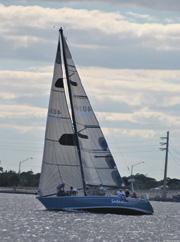
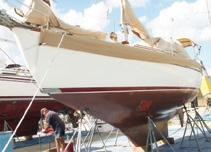

At its Leadership Forum in Florida in February, US Sailing recognized Rosemary Hobart as the Volunteer of the Year for her outstanding work with Youth Sailing Virginia. The US Sailing Volunteer of the Year Award recognizes an individual whose contributions went ‘above and beyond’ while not receiving any financial compensation.

According to US Sailing, the person who nominated Rosemary Hobart for this award noted that it was almost impossible for them to pick a category, as she contributes to the success of Youth Sailing Virginia (YSV) in so many ways. “She is a tireless volunteer, showing up to help run programming, supporting YSV booths at community events, and always lending her hand and experience with fundraising and development. Hobart spent years building the Learn to Sail Program, incorporating STEM, and working with new sailing instructors to become strong leaders. This year,
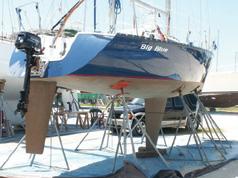
Youth Sailing Virginia was able to hire its first sailing director. Her passion for inclusion has led to the development of engagement opportunities for youth who might not otherwise have the chance to sail.”

Hobart says, “I could do this work until I’m 101 because it’s just so fun and fascinating. One of the best parts is seeing the joy that emanates from the kids when they are learning, especially when they struggle and then overcome an obstacle.”
Hobart was introduced to sailing as a child but took up the sport more seriously as an adult when she learned to helm and began racing sonars. She continues, “At YSV we have a terrific team: a small but great staff and a board of volunteer directors who all bring different creative strengths. I am happy to work among them, and it all comes together because we are working toward the same goal— youth development using sailing as the platform.”
Not only have Hobart’s efforts increased the number of girls and African American students in the program, but she has also developed partnerships with numerous organizations to include the Boys and Girls Club of Virginia Peninsula, City of Hampton Parks Recreation and Leisure Services, Maritime Academy of Hampton High School, Alternatives Inc., and the Hampton Aquatics Center. Learn

As a US Sailing Community Sailing Center, YSV serves as a hub for high school racing, hosting regattas for regional sailing associations, and is a REACH US Sailing STEM Education Center.
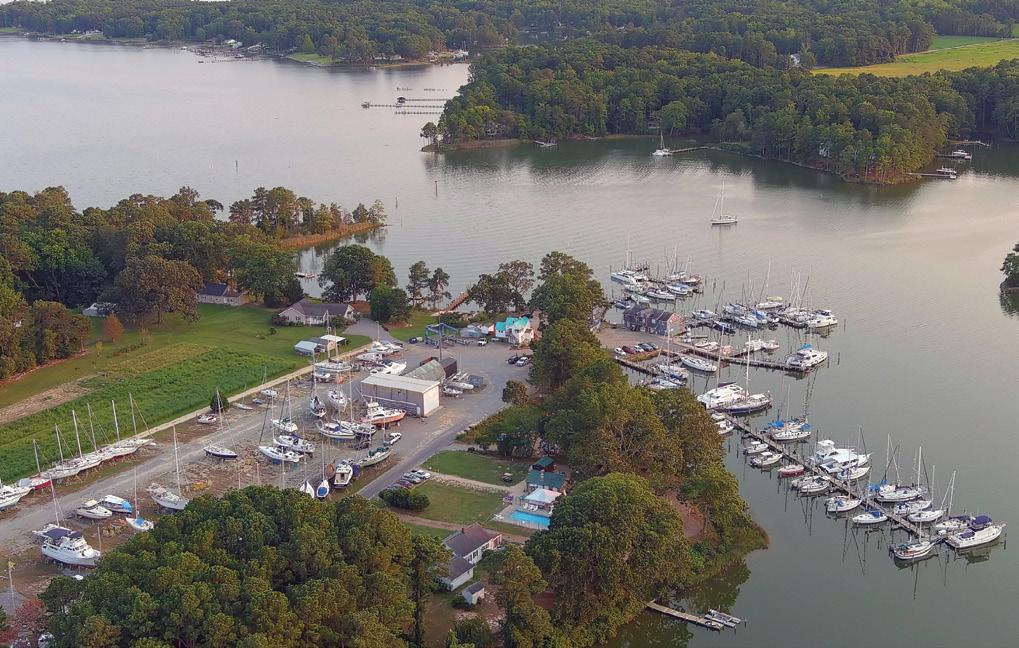
YSV is committed to providing access to all waterfront activities starting with teaching youth water safety. Its sailing program provides sailing instruction by US Sailing Certified Instructors to youth in Beginner, Intermediate, Intro to Racing, Water Safety and Survival, and Family Learn to Sail (all ages).
YSV’s four goals are: to build diversity into its programs so that they reflect the community; to maximize access to sailing programs for youth from all socioeconomic backgrounds; to incorporate applied science, technology, engineering and math (STEM) into the training curriculum; and to teach youth skills that will benefit them throughout their life, such as leadership, independence, concentration, self-reliance, decision making, and teamwork.


If you’ve ever been a liveaboard or a long-term cruising sailor, you have probably found yourself wanting for fresh produce. Some liveaboards and cruisers have managed to grow whole gardens aboard their boats to address this problem—but for the sake of simplicity, an herb garden might be a more approachable starting point. What better way to celebrate Earth Day, April 22, than to try out a green thumb on the water?
First, you’ll need to find somewhere to put your plants. One option is to move them around: store them below when underway and bring them topsides when docked or anchored. Pots that are low and wide can help prevent topples. If moving an array of potted herbs every day is too laborious, find somewhere inside the cabin near a window or porthole
Creative repurposing of old containers and lines may be useful to create a hanging setup. Some sailor-gardeners suspend pots from the cabin top or use things such as cheap shoe organizers to grow a “wall” of plants. Wherever you put yours, ensure that they have ample sunlight and won’t tip over. Besides location, the rest of the normal plant care rules apply. Water appropriately and add compost or other nutrients to the soil. Just be extra sure the plants you bring aboard are pest-free!
For a starter herb garden, go for hardier herbs. Mint will grow in just about any condition, and fresh mint drastically improves an après-sail mojito. Basil,
parsley, cilantro, thyme, and oregano are all relatively hardy and common culinary herbs that will liven up any dish. All of these herbs are also more tolerant of shade, so you’re less likely to find yourself sending dead plants overboard if you forget to bring them topside for a few days or if your cabin doesn’t receive as much light as you’d like.
Ultimately, growing herbs on a boat isn’t all too different from growing herbs in a house, besides the fact that the boat moves. Trial and error will be involved, but nothing beats that fresh, summery addition to your meal after a long day on the water.




 By Kelsey Bonham
By Kelsey Bonham
On February 28, the Virginia Marine Resources Commission (VMRC) voted unanimously to extend the oystering season in some parts of the Southern Bay after a recent evaluation showed that Virginia’s oyster stocks are healthy enough that they may produce the largest commercial harvest in 35 years, exceeding 300,000 bushels.
These extensions include areas of the Rappahannock River, York River, and Tangier Sound, adding 10 working days to the season, effectively extending it by two weeks. Areas that were set to close at the end of February were instead closed in mid-March, while areas set to close at the end of March will remain open until midApril. Sailors going on their first outings of the season might catch a glimpse of the Bay economy normally reserved only for the hardiest winter mariners.
If these extensions allow Virginia watermen to break the 300,000-bushel mark,


that will mean that this season’s commercial catch will be 50 percent higher than last season’s 200,000 bushels. Considering the history of the Chesapeake oyster fishery, this is great news: at the beginning of the 20th century, annual oyster harvests frequently exceeded 1 million bushels, but experienced a sharp decline in the late 20th century due to overharvesting, declining water quality, and the proliferation of diseases including Dermo and MSX. This year’s extension shows that dedicated efforts by governments, nonprofits, recreationists, and watermen to restore oyster populations has started to pay off.
Chris Moore, senior regional ecosystem scientist for the Chesapeake Bay Foundation, said, “Virginia’s latest oyster numbers are another promising sign that oyster populations are continuing to recover in the Chesapeake Bay and its tributaries. We are fortunate to now be able to contemplate harvest increases that
benefit local economics and local seafood lovers.”
While things are looking up for the Bay’s oysters at the moment, however, Moore also cautioned, “The Chesapeake oyster is still in the early stages of a comeback after a tremendous amount of investment… To keep oyster numbers growing, harvest increases must continue to be done slowly, incrementally, and cautiously.”
For more information, check out the VMRC’s website: mrc.virginia.gov
It’s spring splash season when sailboat owners spring commission electrical, water, and other systems. Don’t forget your rigging.
From the BoatUS spring commissioning checklist, we focus here on the rigging section, in which it is recommended that sailboat owners do the following annually:

There’s nothing like the freedom of being on the water, but protecting your boat – and choosing the best product to protect it with – can be a drag. With Micron® Extra SPC, the choice is easy. Its unique Self Polishing Copolymer technology constantly protects against fouling, even when your boat is docked, offering unrivaled, multi-season protection in all waters. Typically reserved for super yachts, this technology is now available for boats coast to coast and for all types of users. Choose Micron® Extra SPC to enjoy your time on the water, wherever you go!
Relentless performance for every boat, everywhere, every time. interlux.com



• Inspect swage fittings for cracks and heavy rust (some discoloration is acceptable). Inspect wire halyards and running backstays for “fishhooks” and rust.
• Remove tape on turnbuckles and lubricate threads, preferably with Teflon. Replace old tape with fresh tape and ensure that water is able to freely drain from it.
• If you suspect the core around a chainplate is damp, remove the chainplate to inspect and make repairs.
• Inspect masthead sheaves and all blocks to make sure they’re running freely.
To get a really good view of small or hard-to-see areas, use a magnifying glass and mirror, and take pictures that can be enlarged on a tablet or computer. A thorough rigging inspection includes checking the deck fittings and chainplates, all attachments to the mast and boom, and more.
For a good checklist, and several articles about rigging inspection, go to boatus.com.
21403 410-267-8681 | 800-456-9151
Nothing heralds spring and the coming boating season quite like spring boat shows. First up:


Dates: April 14-16
Hours: 10 a.m. to 6 p.m. Friday and Saturday, 10 a.m. to 5 p.m. Sunday
Location: Bay Bridge Marina in Stevensville, MD
Tickets: General admission $18 at annapolisboatshows.com, $20 at the gate (children under 12 are free). Limited onsite box office available.
Show Highlights: The most exciting new powerboats from major manufacturers will be on display, along with the latest in navigational equipment, boating accessories, and electronics. Also, the PropTalk Demo Dock, free daily seminars, on-water training with BoatUS Foundation, live music Friday and Saturday nights, and more.
Directions and Parking: From Annapolis, head east on Route 50. After crossing the Chesapeake Bay Bridge, take the first exit on the right for Kent Island (Exit 37), then follow the signs for Boat Show Parking. If directed to offsite parking, a shuttle bus will take you to the show. Parking costs $10 per car. A portion of the proceeds benefit the Kent Island High School swim team.
Dates: April 28-30


Hours: 10 a.m. to 6 p.m. Friday and Saturday, 10 a.m. to 5 p.m. Sunday
Location: City Dock, Annapolis
Tickets: General admission $18 at annapolisboatshows.com, $20 at the gate (children under 12 are free). Limited onsite box office available.
Parking: Boat show visitors are encouraged to park at the Navy-Marine Corps Memorial Stadium and take a free shuttle to and from the show. Shuttles will run one hour prior to show opening through one hour after the show closes. Visit ParkMobile (app.parkmobile.io/venue/ navy-marine-corps-memorial-stadium/ events) if you would like to reserve parking for the spring show dates (cost: $23).
Parking is also available at the Eastport Elementary School for $30 per car (401-405 6th Street, Annapolis, MD) and around downtown Annapolis (find a list of parking options at annapolisparking. com). Be sure to plan ahead as parking garages downtown fill up fast.
Show Highlights: Climb aboard new and brokerage sailboats, meet with charter companies, shop gear and equipment, and catch up with marine professionals and sailing friends. Also don’t miss: VIP experience, Cruisers University, free daily seminars, First Sail Workshop, Tasting Tent, and more.

FAQs: A few more things to keep in mind if you’re planning to attend either show:
• No animals are allowed inside the show unless they are certified service animals.
• Strollers are not allowed inside the show due to safety issues. Please park your stroller in the designated stroller parking area.
• It is recommended that all children wear lifejackets.







• The show is open rain or shine.
• You do not need to print your ticket; they can be scanned from your phone.



• If you leave the show, you will get a hand stamp and will be allowed to re-enter.
For more details and to purchase tickets, visit annapolisboatshows.com.
Chesapeake Calendar presented by
www.goldbelly.com/boatyard-bar-and-grill
SATURDAY MAY 6, 2023
Register online by May 3 Benefits The Bay
For more details and links to event websites, visit spinsheet.com/calendar
national cherry Blossom Festival
In Washington, DC. Opening ceremony
March 25. Parade Saturday, April 15 from 10 a.m. to 12 p.m. Portions of the Parade (Constitution Ave between 9th & 15th Streets) are free to the public along the route and are first-come, first-serve.
maryland Day in Annapolis and Anne Arundel county
Celebrate Maryland’s birthday weekend! Enjoy 60 events at historic homes, museums, and cultural sites in Annapolis and Anne Arundel County all weekend with free and $1 admission events. Find events at marylandday.org
1-2 mtAm Safety at Sea
Three US Sailing-sanctioned certificate courses and one cruising course will be offered. Held at the Naval Academy in Annapolis, MD. Presented by MTAM.
5 SpinSheet happy hour Facebook
liVe: Boat Buying tips Join us Wednesday at 5 p.m. EDT on Facebook or YouTube Live as we talk to marine industry professionals about what prospective boat buyers should consider, research, and avoid doing when buying a boat.
14-16 Bay Bridge Boat Show
One of the largest in-water shows north of Florida, the Bay Bridge Boat Show marks the beginning of the boating season on the Chesapeake Bay. Stevensville, MD. Tickets: annapolisboatshows.com
15 cApcA cpr/AeD & First Aid for Boaters
This program is taught by American Heart Association Certified Instructors who are all experienced boaters. Upon completion of the training, students will receive an American Heart Association Course Completion Card in CPR, AED and First Aid. This certification card has a two-year expiration date, and it is accepted by the USCG for captain’s license requirements. An AHA-approved CPR face mask is required for this course. If you do not have one, a mask will be available for purchase at the class for $15. Time: 8 a.m. to 5 p.m. Location: Selby Bay Yacht Club in Edgewater, MD. Cost: $100 for CAPCA members and SBYC members and their families; $115 for all others. Register: capca.net/classes. Questions? alan@safetyinstituteofmd.com
19 Boat Buying 101
5:30 to 7:30 p.m. in the Van Lennep Auditorium at the Chesapeake Bay Maritime Museum in St. Michaels, MD. Join Wes Williams, CBMM’s Charity Boat Donations and Sales Program Director, for an evening learning the ins and outs of what to expect when buying a boat. Cost: $25. Preregistration required at cbmm.org
22 SpinSheet hampton crew party Sailors of all levels are welcome to come to our crew party to find a boat to sail on or crew for your own boat. 5 to 8 p.m. at Marker 20 in Hampton, VA. Free entrance. Cash bar.
22-23 eastern Shore Sea Glass & coastal Arts Festival
At the Chesapeake Bay Maritime Museum in St. Michaels, MD. This event brings artisans and craftspeople—many from the local DelMarVa area, and others traveling from as far away as New England—who will exhibit and sell coastal and sea-glass related jewelry, home décor, art, and more.

Boater certification course
Boater Certification course offered by America’s Boating Club-Wilmington. Three consecutive Saturdays beginning April 22, 1 to 4 p.m. in New Castle, DE. $35 per person. For information and to reserve a seat call (302) 307-3426 or email matkinsonseo@gmail.com
23 earth Day, our Future planet
At Elk Neck State Park in North East, MD. Stop by the nature center to pick up an Earth Day kit, then enjoy a self-guided walk through the park. Look for local flora and fauna with a scavenger hunt sheet and pick up any litter you may encounter along the way. Day use fees waived for Earth Day participants.
presented by
23 SpinSheet Solomons crew party
Sailors of all levels are welcome to come to our crew party to find a boat to sail on or crew for your own boat. At the Southern Maryland Sailing Association, Solomons, MD, 4 to 6 p.m. Free entrance. Cash bar.
24-27 Golden rule peace Boat Visits
Annapolis
The Golden Rule Project seeks to educate the public about nuclear, peace and environmental issues. We have recovered and restored the original peace ship, the Golden Rule, that set sail in 1958 to stop nuclear weapons tests in the Marshall Islands, and which inspired the many peace makers and peace ships that followed. Free.
28
cmm maritime performance Series
7 to 9 p.m. at the Calvert Marine Museum in Solomons, MD. Doors open at 6 p.m. Beer, wine, soda, and water available for purchase. Tickets: $20 online, $25 at the door. Live music by Lulu’s Fate.
28-30 Annapolis Spring Sailboat Show
Ring in the new season with sailing enthusiasts from around the MidAtlantic for an in-water show showcasing the industry’s latest boats, gear, and tech. Tickets: annapolisboatshows.com
29 All About maryland Festival
10 a.m. to 4 p.m. at Gunpowder State Park (Hammerman area) in Chase, MD. Featuring a live demonstration crafter village; butterfly exhibit; crab cake challenge; “Taste of Maryland” vineyard, brewers, and distillers garden; classic car show, and children’s activities. Free parking and shuttle, $10 admission at gate (ages five and under are free).
29 Annapolis trident Swim
29-30 pirates invade Yorktown Weekend
Step back into the Golden Age of piracy as Riverwalk Landing and the Watermen’s Museum are invaded by seafaring marauders! Enjoy live blacksmith demonstrations and fun for lads and lasses of all ages. Explore a pirate encampment, sing along to sea shanties, take part in a town-wide treasure hunt, and witness exciting cannon demonstrations. Free. 10 a.m. to 5 p.m. both days in Yorktown, VA.
30 SpinSheet Annapolis crew party
Sailors of all levels are welcome to come to our crew party to find a boat to sail on or crew for your boat. At Eastport Yacht Club, 4 to 6 p.m. Free entrance. Cash bar. Live steel drum music by the Geckos.
2 ccVr tune Up races
Hosted by CCV Racing, Southern Chesapeake Bay.
5 hYc Wednesday night racing Begins
Hosted by Hampton Yacht Club, Hampton, VA.
5 - Nov 2
little creek SA Wednesday night racing Norfolk, VA. 6 - Nov 2
BBSA Willoughby thursday night racing
Hosted by Broad Bay Sailing Association, Norfolk, VA.
11 DiSc KiSS Spring Series
Hosted by Daingerfield Island Sailing Club, Washington, DC.
15
Inaugural event to benefit the Navy SEAL Foundation. 5K open water swim (kayaker and wetsuit required). Bay Ridge Community Beach, 7-11 a.m. $150 per swimmer/$50 virtual swim.
BcYA ice Breaker race
Hosted by the Baltimore City Yacht Association.
16 SmSA Spring invitational
Hosted by Southern Maryland Sailing Association, Solomons, MD.
16-30 ccVr Spring Series
Three consecutive
Sundays. Hosted by CCV Racing, Southern Chesapeake Bay.
16 - Sep 26
BcYA tuesday night Series
Hosted by Baltimore City Yacht Association.
20-23 charleston race Week
Charleston, SC.
26 - Aug 30
AYc Wednesday night racing
Hosted by Annapolis Yacht Club, Annapolis, MD.
29 DiSc Spring Fling
Hosted by Daingerfield Island Sailing Club, Washington, DC.
29 mrSA Spring Fling
Hosted by the Magothy River Sailing Association.
29 nASS Spring race to the lighthouses
Hosted by the Naval Academy Sailing Squadron. Annapolis, MD.
29-30 AYc one Design
Hosted by Annapolis Yacht Club.
29-30 tAYc Spring invitational
Hosted by the Tred Avon Yacht Club, Oxford, MD.
30 - May 5
Antigua Sailing Week
Boater certification course
Boater Certification course offered by America’s Boating Club-Wilmington. Three consecutive Saturdays beginning April 22, 1 to 4 p.m. in New Castle, DE.
Certification is mandatory for boaters born after Jan. 1, 1978 on Delaware waters and after July 1, 1972 on Maryland waters. $35 per person. For information and to reserve a seat call (302) 307-3426 or email matkinsonseo@gmail.com



1-4 America’s Great loop cruisers’ Association Spring rendezvous
AGLCA Spring Rendezvous will focus on the route from the Chesapeake Bay to the Tennessee River, including Canada. Seminars and speakers on boat information, marinas, navigation, and more. Held at the Sheraton Norfolk Waterside Hotel and Waterside Marina in Norfolk, VA. AGLCA membership and registration for the event are required.
6 20th Annual BB&G catch & release Spring Fishing tournament
Presented by the Boatyard Bar & Grill. Registration deadline: May 3 (limited to 100 boats). $250 per boat of 4 anglers. Awards ceremony at 5 p.m.; party and band from 4 to 8 p.m. Proceeds support the Chesapeake Bay Foundation, the Coastal Conservation Association Maryland, and the Annapolis Police Foundation’s Youth Fishing Camp. Register: boatyardbarandgrill.com
6 crusader Yachts Demo Day
Call to make an appointment to see in-stock Jeanneau Sun Odysseys and Excess Catamarans (410) 269-0939. Event registration: crusaderyachts.com
6 Yorktown Blues, Brews, & BBQ Festival
Sample more than 30 local craft beers, dig into some amazing BBQ (available for purchase), and listen as some of the best blues musicians in Hampton Roads and beyond take the stage at Riverwalk Landing in Yorktown, VA. Tickets: villageevents.org
15 take Your mom Sailing Day
Known to landlubbers as Mother’s Day.
13 Arundel rivers on the half Shell
Join hundreds of supporters for a fun-filled evening of camp fare, drinks, oysters, and a silent auction, all benefiting Arundel Rivers! 6 to 9 pm at Camp Letts on the Mayo peninsula. $120 admission for one; $210 for two.
20-21 cambridge classic powerboat regatta
Watch on land at Gerry Boyle Park at Great Marsh in Cambridge, MD. 10 a.m. to 5 p.m. both days (weather permitting). Free admission, $5 for parking.
20-26 national Safe Boating Week
The Safe Boating Campaign is a worldwide effort focused on responsible boating, encouraging boaters to always wear a life jacket while on the water.
23 Blue Angels Flight rehearsal Blue Angels practice for 2023 USNA Commissioning Week Show starting at 2 p.m. above Annapolis.
June 15 – 18, 2023 | Harbor East Marina, Baltimore, MD
Hosted in Baltimore's Inner Harbor, the 2023 Hunter Rendezvous will include two evenings of live entertainment, gourmet food and drinks, kids’ activities, educational seminars, lunch with Hunter sailboat designers, optional tours of the National Aquarium, Fort McHenry and much more. Don’t miss the opportunity to be a part of this epic celebration!

Register today at HunterRendezvous.com


A world-class gathering of Hunter and Marlow-Hunter owners in a stunning locale
24 Blue Angels Flight Demonstration
Blue Angels fly starting at 2 p.m. over Annapolis. Congratulations to USNA Class of 2023!
Antigua Sailing Week
1-4 Santa maria cup Women’s Match Racing Championship hosted by Eastport Yacht Club, Annapolis, MD.
5-7 helly hansen Sailing World regatta Series Annapolis
Formerly known as the NOOD. Hosted by Annapolis Yacht Club.
9 DiSc KiSS Summer 1 Series
Hosted by Daingerfield Island Sailing Club, Washington, DC.
13 AYc Spring harbor regatta
Hosted by Annapolis Yacht Club.
13 AYc Spring race to oxford
Hosted by Annapolis Yacht Club.
13 West river to cambridge regatta
Hosted by the West River Sailing Club in Galesville, MD, and Cambridge Yacht Club in Cambridge, MD.
14 choptank challenge
Hosted by the Tred Avon Yacht Club, Oxford, MD.
19-21 rYS/AYc team race challenge
Hosted by Annapolis Yacht Club.
20 BBSA cape henry cup
Hosted by Broad Bay Sailing Association, Norfolk.
20 eWe Spirit cup
Hosted by Sailing Club of the Chesapeake.
20 Five Forts race
Hosted by the Rock Creek Racing Association and Maryland Yacht Club.
20-21 hYc hospice one Design regatta
Hosted by Hampton Yacht Club.
21 opcYc Yankee Station Series 1
Hosted by Old Point Comfort Yacht Club, Hampton, VA.
26-27 the Down the Bay race
A 120-mile race down the Chesapeake. Hosted by Hampton Yacht Club.

27 miles river race From Annapolis to St. Michaels, MD. Hosted by the Miles River Yacht Club.
27-28 prSA Spring regatta
Hosted by the Potomac River Sailing Association, Washington, DC.


When I was 12 years old my family started spending summers in a cottage on Herring Bay, and my father bought a used small centerboard sailboat. We would go out for a few hours on a weekend when the weather was fine and winds were moderate. When we came ashore we’d pull her up on the beach using a log as a roller.
I had always thought sailing would be very peaceful, and that was true in those outings with my dad. We would pack snacks, drinks, and often a book and glide around Herring Bay, but other than a few Herring Bay outings with friends on Sailfish or Hobie Cats (which were very exciting in storms and a trapeze), I didn’t sail again until I started racing in Herring Bay with Herrington Harbour Sailing Association (HHSA). This was when I realized that sailing could be exhilarating.
For about five years I participated in all the HHSA races and many onedesign and CBYRA races on MaryBeth, a Catalina 27. This was how I really learned to sail. Over the years I raced with Pursuit, Coyote, Labyrinth, Widow Maker,
Delirium, and of course rarely missed a race with my husband Keith Mayes on our Beneteau 36.7 Jubilee. We keep Jubilee at Pirate’s Cove Marina, but for many years prior she was at Herrington Harbour. We’ve raced her with amazing crew for over 15 years.
Beyond the Bay, I’ve raced from Annapolis to Bermuda, Newport to Bermuda, and in the Beneteau 36.7 North Americans on the Great Lakes in Buffalo, NY, and Detroit, MI. As far as cruising, I’ve sailed in the BVI, Bahamas, Cape Cod, and Maine, and I hope to do more cruising on the Bay and elsewhere.
On the value of women’s


I’m a big fan of women’s regattas and started participating in them at the Southern Maryland Sailing Association and with HHSA, where I have helped build and support the Women Underway Program. Sometimes it may be harder to be taken seriously as a female on the boat; however, I was given a lot of respect and responsibility on my first race boat MaryBeth. Women’s regattas and cruises help give women opportunities to gain experience and build confidence handling any role on a boat.
If someone were interested in learning to sail, what would you tell them?

Find a boat to race on. Attending the SpinSheet Crew Party (see opposite page) or contacting a racing club are two good ways to find such a boat. Racing relies on the optimization of a boat’s abilities and the need to keep your eyes both inside and outside the boat. Find a boat, show up to the dock early, bring drinks or snacks, learn to rig the boat, ask questions, follow the skipper’s instructions, and have a positive attitude.
Our next chapter will find us setting a course for family fun on a powerboat. We are selling Jubilee, which will be a huge change. However, the grandkids at ages two and four are still too young to race, so we have big plans for tubing, teaching grandkids to waterski (Keith and I were both ace waterskiers back in the day, especially Keith), and exploring destinations around the Bay.



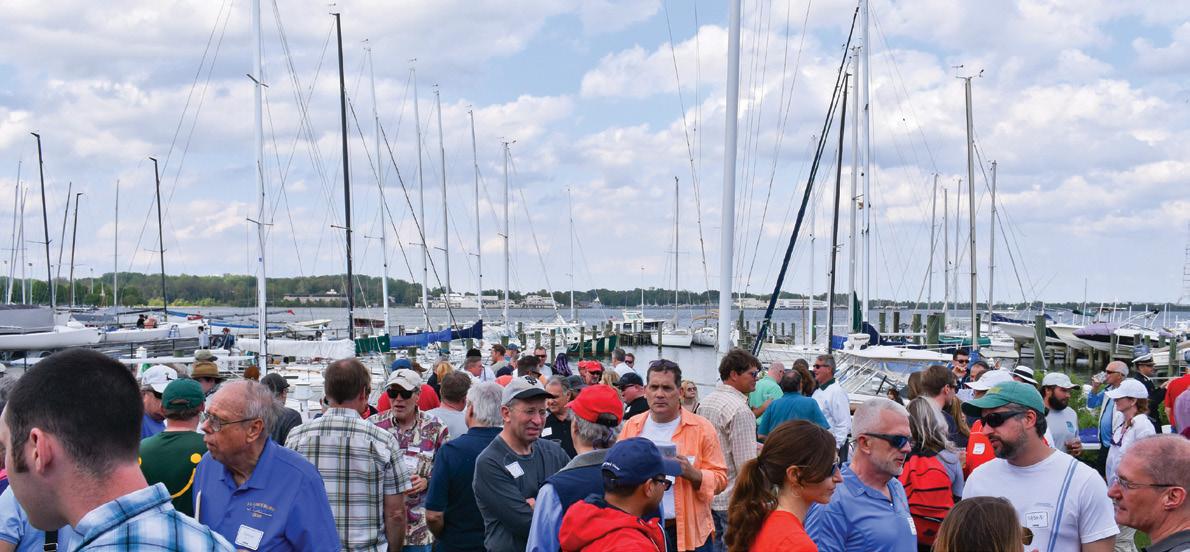

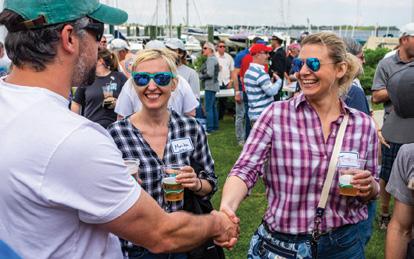

New sailors or those returning to sailing may want to seek instruction or coaching at a sailing school or club. Many such organizations
exist on the Chesapeake Bay and offer courses and certifications for beginners, returning sailors brushing up on seamanship skills, cruisers seeking bareboat chartering or navigation experience, and racers looking to hone their skills and move up in their fleets. Finding the right type of instruction for you is important—in many ways, it can make or break your experience with the sport. Consider what you want and need in your sailing
New sailors or those returning to sailing may want to seek instruction or coaching at a sailing school or club. Many such organizations exist on the Chesapeake Bay and its tributaries. They offer certifications for beginners, returning sailors hoping to brush up on seamanship skills, cruisers seeking bareboat chartering or navigation experience, and racers wanting to hone their skills. The following is a sampling of schools and clubs that offer sailing instruction on the Chesapeake. For a more complete list of schools offering certifications outside this region, visit US Sailing or American Sailing.
• Annapolis Sailing School annapolissailing.com
education before you commit. Is budget a concern? What about group vs. private lessons? How important is flexibility? What about the average age of your fellow students? Here at SpinSheet, we want to help you find the best sailing school for you, that has everything you need and fits within your budget, so that you can be empowered to not only take that first step but continue learning about and enjoying sailing for decades to come. So, we compiled a list of a sampling of schools and clubs that offer sailing instruction on the Chesapeake Bay and its tributaries, found at startsailingnow.com. For a more complete list of schools offering certifications outside this region, visit US Sailing (ussailing. org) or American Sailing (asa.com). Find more about sailing schools on page 41.






• Captain In You Sailing Schools, Inc. captaininyou.com


• SailTime sailtime.com/annapolis
• Annapolis Naval Sailing Association ansa.org
• Blue Water Sailing School bwss.com
• DC Sail dcsail.org
• J/World Annapolis jworldannapolis.com
• Sail Solomons sailsi.com
• West River Sailing Club learn2sailwrsc.com

Sailing for almost everyone is either a recreational or competitive pursuit. For Matt Rutherford, sailing is a calling. It has challenged him to compete against himself. Pursuing a calling helps define your life and its mission. Sailing pulled Matt away from a world of a religious cult, rehab, juvenile detention, and eventually prison. Finding his calling has given him a new life, while inspiring sailors and others around the globe.
Matt has always followed his calling with his own skills and a shoestring budget. He has settled in the Chesapeake
 By Greg Walker
By Greg Walker
Bay region for his base in advancing the science of ongoing changes in our oceans, particularly in the northern latitudes around the Greenland ice sheet.
Most know of Matt because of his solo, non-stop sail over 309 days in 2011 and 2012 to circumnavigate the Americas. His effort broke two Guinness World Records: as the first person to accomplish this and as the smallest vessel ever to cross the Northwest Passage. Sailors around the globe followed his effort on his website.
He sailed this epic voyage aboard a donated 40-year-old, 27-foot Albin Vega which he repaired and fitted for the effort. This audacious feat was memorialized in the inspirational and beautiful documentary “Red Dot on The Ocean” (which is available on PBS and various streaming services). Watch it with friends and family if you have not seen it. Consistent with his efforts to always do good, this sail raised money for Chesapeake Region Accessible Boating to help others also find fulfillment on the water. The international Ocean Cruising Club awarded Matt the 2012 Jester Medal for an outstanding contribution to the art of singlehanded sailing.
Matt’s calling has always been fulfilled on donated or well-worn vessels that require his self-taught sailing and mechanical skills. Matt did not learn to sail until he saved enough to buy a 24foot Coronado in 2004 and cruised it from the Chesapeake to Florida. Three hurricanes crossed his path that year. His next vessel was a Pearson 323 sailed singlehanded twice across the Atlantic to Gambia, the North Sea, and the Bay
For the record-breaking and award-winning voyager, sailing for the greater good remains the focus.# Matt Rutherford onboard Marie Tharp in Greenland for the Ocean Research Project. Photo by Phineas Alexander
of Biscay among other places. He sailed a borrowed 29-foot boat across the Pacific to study plastics in the ocean. In between these adventures Matt saved just enough from odd jobs and boat deliveries to plan for his next adventure.
Matt scraped up enough to buy Ault, a rusted and decrepit 42-foot steel catketch that needed 12 steel plates, among a lot of repairs, before it could reliably float. He sailed her across the Atlantic and studied a garbage gyre along the way. He sailed her to Greenland to conduct research.
In between these adventures he founded his next audacious adventure: the nonprofit Ocean Research Project (ORP), a donor-funded, grass-roots effort to match governments, sailors, scientists, and educators to study and preserve the oceans we all love. All the research is conducted on sailing vessels with a small fraction of the daily operating costs and carbon footprint of other research vessels. The focus is on the northern climates where ocean changes are occurring rapidly. Work in the Chesapeake is also taking place.
Matt’s reputation as a doer resulted in the donation to him of a steel-hulled, 72foot Bruce Roberts Voyager design. The vessel was a shell and required donations and two years of work by Matt and other volunteers to build her out. Christened
the research vessel Marie Tharp, she had her maiden successful voyage to Greenland for research in summer 2022. Her steel hull permits work in ice-filled waters more safely. She is named after Marie Tharp (1920-2006), an underrecognized cartographer and oceanographer who published the first maps of the ocean sea floors which helped establish the science of seabed formation and continental drift.
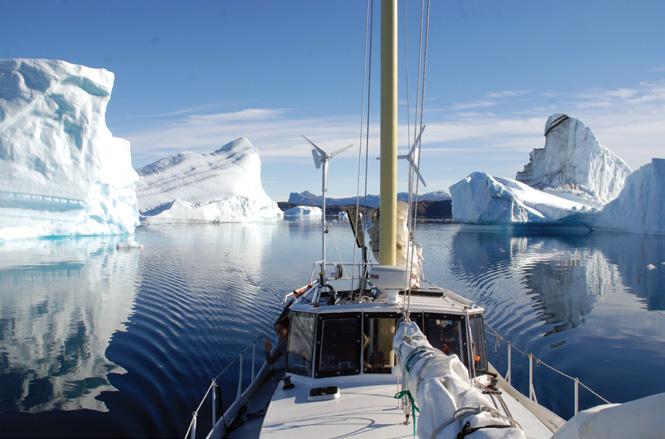
These many achievements led the Cruising Club of America to select Matt as the 2021 Young Voyager of The Year
Award. The Covid lockdowns prevented Matt from receiving the local recognition that such an award deserves. Even so, the local and global sailing community can help Matt pursue his calling. ORP accepts tax deductible donations of cash, services, supplies and boats. Sailors may purchase berths to travel and learn with Matt and his crew on different legs of the voyage from Annapolis to Greenland and back between May and October. As an energetic, knowledgeable, and entertaining speaker, Matt only asks for donations to Ocean Research Project: oceanresearch.org. Contact him at oceanresearchproject@gmail.com #
About the author: Annapolis sailor Greg Walker has written various articles for SpinSheet over the years. He serves on the board of directors of the Ocean Research Project.


The historic Maryland harbor town of St. Michaels gives sailors plenty of well-known reasons to visit. From the picturesque Chesapeake Bay Maritime Museum, Talbot Street’s unique and interesting shops and restaurants, or picking crabs at The Crab Claw, to the renowned Inn at Perry Cabin where the movie “Wedding Crashers” was partly filmed. Been there, done that.
Peeling back the onion a layer or two reveals a treasure trove of events, activities, and attractions to give sailors numerous new ways to visit and enjoy the beauty, arts, culture, and history of St. Michaels. Here are some of my personal favorites:


Taste of St. Michaels
There’s no shortage of great restaurants in St. Michaels, so what better way to sample them all than a “tasting crawl” all in one day? Scheduled for Saturday April 15 from 11 a.m. to 4 p.m. this year’s event gives visitors a chance to sample food and drink selections from the town’s award-winning restaurants and other participating businesses, with tastings ranging from $1-$5 (stmichaelsmd. org).
If you miss this event, have no fear! Simpatico provides free tastings handpicked Italian wines every weekend and all week long, in its courtyard or shop located at 104-106 Railroad Avenue, just off Talbot Street.
For early risers and car enthusiasts alike, why not stroll over to the Classic Motor Museum St. Michaels for their one of its weekly Saturday Morning Brew in the Barn gatherings for coffee and camaraderie amidst their impressive collection of antique and classic cars. Located at 102 E. Marengo Street, it’s free for members, $5 for guests, and runs from 9-11 a.m. The collection includes a rotating array of pre- and post-World War II classic automobiles, mid-century muscle cars, vintage trucks, motorcycles, and other era-inspired collectibles.
If the ideal start to your day involves sipping mimosas on the wrap-around porch of an historic home built in 1806, then The Galley Restaurant has just what you need. Operated as a hotel for a decade until 1901, the building was later converted into a bank until 2013, where it now runs as a restaurant, complete with the bank vault still in place. Ghost hunters have spent nights in the home to witness paranormal activity spanning from more than two centuries of former residents and guests who visited there.
It’s nearly impossible to be out on the Bay any given weekend in-season without seeing some sort of sailboat regatta taking place. But seeing the log canoe races of the Miles River Yacht Club (MRYC) is something truly special. According to the MRYC website, these gorgeous boats started racing on the Miles River in 1840. Today, a fleet of about a dozen log canoes dating back to the 1800s or early 1900s still race near St. Michaels from June through August. Starting this year, the Chesapeake Bay Maritime Museum will provide log canoe race charters, giving visitors front row seats to watch a log canoe race from a CBMM charter vessel. For this year’s racing schedule, visit milesriveryc.org, cbmm.org, or spinsheet.com
St. Michaels and the area west of town across Tilghman Island is known as District 5, The Bay Hundred of Talbot County, and boasts more than 600 miles of shoreline, providing a variety of parks, trails, and streams for outdoor venturers
of all types. Right in town, Shore Pedal and Paddle provides bikes, kayaks, and standup paddleboards to rent or purchase. Several bike trail routes are clearly mapped out, including the 38.2-mile Chesapeake Views trek down Tilghman Island, the 29.6-mile Oxford/St. Michaels trek via Easton, and others throughout the region. Find free trek maps at tourtalbot.org.
For the kayakers, several tours are also mapped out and range in distance from two to eight miles in length. Chesapeake Bay Maritime Museum also offers a fourhour, guided “Paddle & Tasting” tour on Saturday, June 3, which concludes with a wine tasting at Triple Creek Winery.
Visitors who prefer to explore on foot can enjoy this short 1.3-mile paved hiking trail where the Baltimore, Chesapeake, and Atlantic Railway once carried passengers to the beach resort town of Ocean City, MD. Nearby Easton has converted another section of the former railroad tracks to a 2.5-mile hiking path running right through the center of town.
If you’re looking to support area farmers and access fresh, locally grown produce, be sure to visit the St. Michaels Farmers Market, held every Saturday from April through November at Muskrat Park.
If you are traveling to St. Michaels by boat, there’s a wonderful anchorage called Shaw Bay located just up the Wye River near the north end of the Miles River. A narrow peninsula provides protection from the western winds and a breathtaking sunset vista. The cove is quiet and feeds into the Wye Island River Sanctuary, where Wye Island Natural Resources provides a labyrinth of hiking trails throughout this protected wildlife area where bald eagles nest.
Whether you’re seeking adventure on the water, on foot, or on a bike; or in taking in its history or culinary delights, St. Michaels offers so much more than the typical “haunts.” Be sure to plan on adding some of these lesser-known activities to the agenda for your next visit there.
About the author: Captain Steven Toole covers cruising, destinations, and other Bay-related topics for SpinSheet. An active racer and cruiser of his J/120 Hot Pepper, he holds a USCG Master Captain’s License and serves as vice president of the Chesapeake Racer Cruiser Association.

As sailing season begins, sailing schools around the Chesapeake Bay are ready to welcome students. Owners and staff of such schools have spent the winter maintaining their boats, researching and sometimes investing in new boats, upgrading school facilities, refining programming, and selecting instructors for the new season. Whether you are brand new to sailing or you’ve been sailing a while and seek to enhance your skills, a springtime or summer sailing course is an excellent way to reach your goals. Cheers to all who aim to improve their sailing skills this season!
When it comes to choosing a sailing school, we are fortunate that there are many quality sailing schools around the Chesapeake Bay. Like colleges and universities, sailing schools tend to have their own “feel.” Shop around, ask questions, and find one that fits you and your goals.

Ricky Nelson, director of sailing programs at Annapolis Sailing School, suggests these questions be among those on your list of inquiries.
1. How are the students’ days planned?
How much time is spent on the water and in the classroom? You can learn about sailing from a book or YouTube video, but neither of those can give you the practical experience you gain from being on the water with an instructor.
2. What is the school’s model for continuing education?
Can the school help you with additional time on the water after the course has ended? Does the school’s progression of courses align with your goals? For example, is your goal to win races, pass a charter certification, sail your own boat better and/or farther? Annapolis Sailing School offers a sailing club and casual racing for continued practice after your course ends.
3. What type of boat will I be sailing on?
It is important to know what type of boat you’ll learn on and whether it is similar to the type of boat you want to sail after the course has ended. Is there a progression of boats from small to large as your sailing skills grow?
4. Why did the school choose these boats for teaching?
At Annapolis Sailing School we believe our boats are good for learning on because they are stable, simple, and sturdy enough that they are forgiving of mistakes.
5. Who do you hire as instructors?
What are the required certifications and experience, but also, what other traits does the school look for in an instructor?
It’s important that instructors understand the students’ point of view. Where are they coming from? What experiences have they had? Do the instructors appreciate the different ways that students learn? There are multiple ways to teach sailing skills. Do the instructors have several methods at their fingertips?
Many people wonder what size boat is the best to learn aboard. Opinions vary, and the answer depends in part on what type of boat you ultimately hope to sail.

 Jeff Bowen, founder of The Sailing
Jeff Bowen, founder of The Sailing
Academy, located at Herrington Harbour, says, “When our staff searched for the perfect boat as a teaching platform for our school, we said the boat has to have a huge cockpit, perform well, be a quality build, with a simple and modern design, and be affordable. After looking
for 15 years, we didn’t think that boat existed.
“Then, online we stumbled across VIKO Yachts. They seemed too good to be true, so a team of us went to Poland in 2021 to visit the factory and demo sail some of their yachts. I immediately placed orders for two VIKO S26 yachts. Since there were no dealers in the United States, The Sailing Academy had to become the US importer. The boats arrived in May of 2022, and it was worth the effort.
“All of our students and instructors loved the performance and ease of learning on the VIKO S26s. They held up really well over a season of hard sailing. From my opinion, it is the perfect boat for the Sailing Basics course and ASA101. We also ordered VIKO S30 and S35, which arrived late last year and will be shown at the Annapolis Spring Sailboat Show.
I think the S30 is the perfect “first boat” for new sailors. It is fast, easy to sail, yet comfortable enough for weekending on the Chesapeake Bay. I have


not seen anything that can match the value, performance, and comfort. In addition to upper-level instruction, we will offer club memberships on the S35. The S26, S30, and S35 will be available for charter and purchase.”
Boat ownership is not necessary to a lively and rewarding sailing life. Many avid sailors do not own a boat. In our sailing world, we have a term: OPBs, which stands for Other People’s Boats. Lots of good sailors sail on OPBs, and you can too. In addition to friends who own OPBs, you may find OPBs at sailing clubs and charter companies, and many sailing schools have associated club boats for students to use after completing instruction.
Bryan Bay of West River Sailing Club (WRSC) explains, “We don’t want new sailors to drop out of the sport because of lack of access to a boat or sailing friends to practice with. WRSC’s instructional and shared boat programs were specifically designed to
make sure these sailors don’t experience those shortfalls at our club.
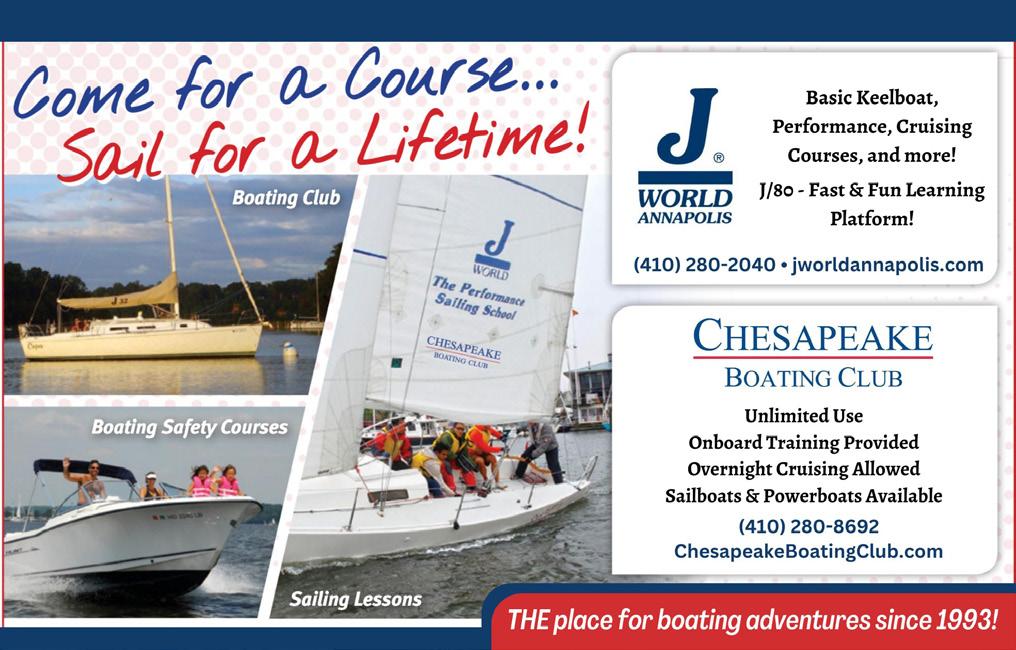
We teach in a universal way, one that gives an understanding of how to read sails and feel a boat, rather than what to do on any specific boat, giving new sail-
ors a better chance at being able to pick up any boat they choose. Students in our adult Learn to Sail sessions then get to continue growing their skills and comfort on the water because a year’s subscription to our shared boat program is in-

cluded with the course. This gives them access to WRSC’s club-owned Flying Scots, Albacores, and ILCAs (formerly Lasers).


“After the introductory class, we offer ‘bridging programs’ and more advanced instruction. New this year are ‘River

Tours,’ pursuit-style, longer races using permanent marks around the river to help new sailors/racers become more comfortable with being close to other boats. We aim to bring new skipper and crew pairings together in a low stress environment, and it will come with an
onshore social scene afterward.”
Another way to get time on the water without purchasing a boat is to take lessons through a charter company and then sail on its fleet of boats. SailTime offers such programs at SailTime Annapolis and SailTime Chesapeake Bay South (in Norfolk).


Tammy at SailTime Annapolis says, “If possible, its advantageous to learn on a boat similar to the one you’ll be sailing after your class ends. At SailTime Annapolis we offer ASA 101, 103, and 104 courses taught aboard our beautiful Beneteau and Jeanneau sailboats. Our 101 instruction takes place on Beneteau First 22s, which were specifically designed for teaching by American Sailing and Beneteau. After completing ASA 101, to get practical experience many of our SailTime students join our membership program. They may also rent one of the Beneteau 22s on weekdays. More advanced sailors have membership options that include bigger monohulls or a catamaran.
“Our students range from new sailors to individuals who want to sail around
the world. Sailors with a strong sailing resume may be able to test out of some courses if they are looking for certifications for chartering. And although we are an adult sailing school, we teach whole families, including children, in tailored programs on weekdays.”



Sailing school isn’t just for new sailors. Plenty of seasoned sailors choose to enroll in sailing schools to hone their skills. Whether you’ve taken a few years sabbatical from sailing, want to get certified for chartering, or seek to take your racing game to the next level, advanced training is available.
Emily Decker says, “At J/World Annapolis, performance sailing instruction means small class size, training tailored to the students’ present skill and knowledge levels, and communicating not just the how-to side of sailing, but also ‘why.’ We teach the basic level courses, but we offer advanced training too.”
Next month, J/World will partner with North U to offer aspiring and experienced racers a skill-building program in conjunction with the Helly Hanson Sailing World Regatta Series. The program will include a two-day racing clinic with classroom seminars and on-water training (May 3 and 4) followed by three days of regatta racing (May 5-7). During this “regatta experience” a North U coach and four sailors




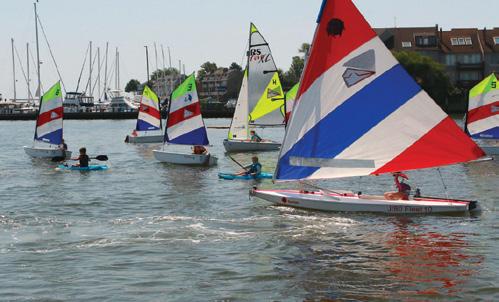
will compete on J/World’s J/80s for both the clinic portion and the regatta.
“It can be intimidating to start racing,” says North U’s Bill Gladstone. “This program offers practice and real racing experience. At the regatta, the sailors do all the sailing, but we like putting a coach on the boat to coach elements that can be difficult to mimic in practice, such as race tactics and managing the rest of the fleet.”




There are several community sailing centers in the Chesapeake region that offer sailing instruction for adults and children. Sail Nauticus (Norfolk), Baltimore County Sailing Center, The Downtown Sailing Center (Baltimore), and DC Sail are among those with well established programs.





“Community sailing centers often serve as an essential ‘gateway’ to waterfront and boat access,” says Traci Mead of DC Sail. “Although membership with the organization may be required, it is typically quite affordable. Our DC Sail members/ students represent a very diverse demographic with everything from young professionals through retirees, and as DC is a very transient city, our students develop new and potentially lifelong friendships with persons hailing from across the globe. At DC Sail we host a comprehensive training program for our new and returning instructors just prior to the kickoff of each season with the goal of assuring consistency of curriculum even if our students have different instructors as they complete their course.”
Community sailing centers generally offer many opportunities to sail their boats after instruction ends. Most also offer beginning racing opportunities and a dynamic sense of camaraderie. No matter which type of sailing instruction you end up choosing, get ready to meet some remarkable people. Sailors are full of adventure and generally eager to share their love of the sport with anyone looking to gain or improve their on-water skills. #
When I first got into big boat sailing, the bigger the wheel, the cooler the boat. Now we’ve got America’s Cup boats ripping around with wheels no bigger than a MINI Cooper’s, so who knows what’s cool anymore? But in addition to practical considerations such as making it impossible to move around the cockpit or having the wheel clang against the floor or cockpit seats, changing the wheel diameter and leaving everything else the same will affect the load you feel in your hand while steering. This probably makes intuitive sense.
A larger diameter wheel gives you greater leverage over the steering forces generated by the rudder. This makes the steering forces feel “lighter,”
 By Dave Kirkpatrick of Edson Marine
By Dave Kirkpatrick of Edson Marine
where going to a smaller wheel makes the steering forces feel greater. Note that the forces transmitted to the wheel are unchanged, but how you interpret them changes. There are different ways to change the actual force that the rudder generates. Heel angle, balance of the sail plan and sail trim, boat weight, speed, and rudder shape/ size/balance will all change how much rudder force is generated. For those of you familiar with polar diagrams, the rudder load map of your boat will roughly match the polar diagram— where the polars go out, rudder loads are high and vice versa.
When we design steering systems, we take all of those loads into account as well as possible and tailor
the gear ratio to be appropriate to the desired helm loading. Helm loading is an interesting one, as you and I could easily have different preferences given different sailing styles, and it also affects the responsiveness of the steering. Steering with a higher gear ratio will be lighter and take more degrees of wheel turn to turn the boat a given amount. We have superyachts with our steering that take 10 turns to do the full (standard) 72* steering sweep, while your standard 35-footer will only take one-and-change wheel turns to go from hard-over to hard-over. Ten turns stopto-stop gets a little dicey when you’re bringing a 120-footer into the slip, so these boats often have variable steering gearing: a topic for another day.
Wheel size is downstream of all of that, so it will only affect your ability to manage those stresses. Have a look at the spreadsheet, which is part of a worksheet that we use when working on a new steering project.



Notice that “Turns HO-HO” (hard over one way to hard over the other way) stays at 1.27 in both columns, while the “Turning Force” changes by 20 percent. Apart from a lighter helm, the big change you’ll feel here is the amount of distance your hands will move to make any given direction change. Sailing upwind in steady displacement conditions, a large wheel will give a huge degree of resolution—you move the wheel a hand-width or two, and that’s a very subtle adjustment. The same movement with a tiny wheel

would send the crew scrambling to prepare for a tack. The other side of this is downwind in feisty breeze and waves, where smaller wheels give you an amazing ability to quickly change course for changes in wave or apparent wind dynamics.
Fundamentally, if the naval architect and steering designer have done their job correctly and chosen an appropriate wheel size, your steering should feel pretty darn good for your boat’s intended purpose.

As sailors, we sometimes like to pretend that our engines don’t exist. But whether we like it or not, they are often a crucial part of what we do, particularly on the Bay. Regular maintenance, especially oil changes, are essential to making sure our engines are the fail-safe that we expect them to be. Oil should be changed approximately every 100 hours; although some opt for every 50, while others extend it to 200. Oil should also be changed during spring commissioning if it wasn’t changed in the fall before winterizing. Changing your own oil may seem daunting, but it only takes a few tools and a few steps and will save you a lot of money in labor.
An oil tray or other container for the used oil (aluminum roasting pan, gallon jugs, etc)
A socket wrench to open your oil pan or a pump and fittings for the dipstick
Oil absorbing pads and rags
Disposable gloves
Trash bag
Strap wrench or very large pliers
New oil
New oil filter
Funnel
Step One: Consult Your Manual
Find your engine’s manual or use the model number to access an online version. Your manual will tell you exactly what oil you need and how much as well as what oil filter you need. Oil and filters can be found at marine supply stores and, depending on what exactly you need, at auto parts stores.
For the old oil to drain out easily, the oil should be hot. More importantly, running the engine will allow all of the gunk that you’re trying to remove to disperse back into the old oil, instead of remaining settled on the bottom and stuck inside the engine. Five minutes at idle is probably enough—it doesn’t need to be at full temperature, just warm.
Ideally the oil pan, located at the very bottom of the engine, will be accessible. There should be a bolt at the lowest point in the pan. Position your oil tray underneath the oil pan, accounting for the fact that it may not stream out directly downward. Place oil absorbing pads around the tray to catch splash. Remove the bolt on the bottom of the pan using your socket wrench, and allow it all to drain out.
If the oil pan is not accessible, doesn’t have a drain, or there is not enough room underneath the engine to fit a tray, you may have to pump the oil out of the dipstick tube. If your dipstick tube is threaded, you may be able to find a fitting for it. If not, you will need a pump with a hose that extends all the way down the dipstick tube to the bottom of the oil pan. Marine supply stores sell a variety of manual and electric pumps that can achieve this. When selecting a pump, keep in mind that it will need to handle hot oil and that diesel engine oil is often heavier than gasoline engine oil, requiring a stronger pump. In my experience, the hand pumps always work, although they can be a bit of a workout.
If pumping through the dipstick tube, remove the dipstick, attach or insert your pump, and pump the oil out into a bucket, jug, or other container. When
it starts to run dry, reposition the hose running from the pump into the engine and try again, repeating until it seems like all of the oil has been removed. You can use your manual, which tells you how much oil should be in the engine, to gauge when you’re done.
If you can’t find the oil filter on your engine, consult your manual. The oil filter and secondary fuel filter may look very similar, so make sure you’ve found the correct one. Use your strap wrench or large pliers to remove it and remember that it will still be partially full of oil, so tip it upright as soon as possible. Have a container and oil absorbing pads ready, especially if it is attached to the engine upside down or horizontally.

To install the new filter, pour some of your new oil into it (as long as it won’t spill out while installing) and use your fingers to rub some new oil onto the gasket. This will improve the seal. Screw the new filter on until the gasket makes full contact, and add another three-quarter turn. It doesn’t need to be overly tight.
If you drained your oil from the pan, make sure you put the bolt back. If you drained it from the dipstick tube, put the dipstick back. Somewhere on top of the engine should be a cap, ideally with an identifying symbol on it, where the new oil should be poured in. Open this cap and use your funnel to pour in the amount recommended by your engine’s manufacturer. Go slowly and check the dipstick frequently. It’s better to take a few extra minutes to double-check than to overfill it and have to drain some of your new oil. When you’re done, put the
cap back, run the engine for a few minutes, and check the dipstick again, adding more oil if necessary.


If you drained your oil into a tray or other open container, transfer it into a container that can be closed and transported. The now-empty jug from your new oil is a great option. Bring your old oil to a facility that can properly dispose of it— many auto parts stores can do this, or your marina may have their own disposal program. Just make sure it doesn’t go in the trash!






An oil filter. The hole in the middle is where you pour new oil into before installing it, assuming it’s attached to the engine at an angle so that it won’t all spill out when installing. The black O-ring gasket is where you’ll want to rub some new oil with a gloved hand before installing to improve the seal.

Changing the oil in an outboard motor follows the same steps. The only difference is that you’ll likely have to remove coverings to access the drain, filter, dipstick, and entry point for the new oil.

This should also be done on land to prevent spillage, meaning you’ll need muffs or a large bucket of water to ensure that the engine is properly cooled while running. #
About the author: Kelsey Bonham is based in Norfolk, VA, where she keeps her 50-year-old, 30-foot steel boat Little Wing, which she restored with her dad during the pandemic. When not writing for SpinSheet, she is an educator at the Virginia Aquarium.

Savannah Gross completed her On-the-job Training at Hartge Yacht Yard. “Peaney” Matthews (left), her 40 year veteran supervisor, taught her much about painting, varnishing, and various marine paints. Gross claims she has an “amazing boss” and thinks the best part of her job is working outdoors. She currently works at Hartge Yacht Yard full-time and looks forward to furthering her career in the industry.



Even experienced sailors don’t often get an invitation for an ocean passage. I was thrilled when, after 60-odd years of handling tillers and sheets both as skipper and crew, I was offered to sail the ocean blue. After all, departing the Chesapeake Bay, leaving behind December’s chill on a 1300 nautical-mile jaunt to the savory waters of the Virgin Islands, what could possibly go wrong?
Wildflower, a Little Harbor 54, is a head-turning Ted Hood design
displacing 65,000 pounds. With three staterooms, three heads, and a workshop, her functional galley spaciously houses dry, cold, and frozen stores. Her 73-foot mast stepped to the keel/centerboard screams for bluewater just as her carefully crafted teak interior defines an erudite owner.
In early November, I said “yes,” honored to be among four who would make the passage. After weeks of wrestling departure dates, delayed
first with engine surprises and then by unsafe weather, we departed Norfolk on December 13, a gray morning with inescapable cold smartly nipping each of us. Surely, I thought, I’d fly home before Christmas.
All four sailors were well-qualified; all had crewed ocean races, and all have owned cruising sailboats. Still, nagging little doubts popped into my head—this was the Bermuda Triangle. I decided to ask Skip Pond, owner and prep
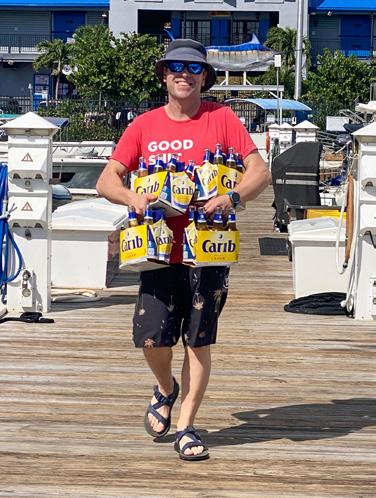

Offshore Series presented by
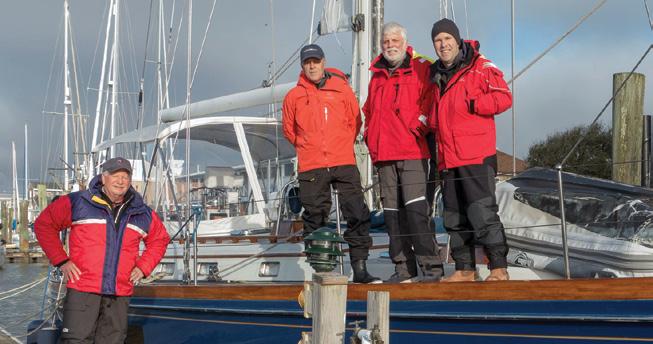
school classmate, how many times he’d done this. “This will be my 51st trip to the Islands,” he said calmly. Phew
I unearthed a packing list developed when crossing the Florida Straits in 2017 and began gathering gear. I updated the list with help from experienced passage sailors, gathered more gear, and shed all that wasn’t vital. Almost overlooked and utterly critical was the last item: a strapon headlamp that beams red or white.
We departed Norfolk at 0900 on the 13th, needing at once to acclimate to winter’s chill and the incessant motion of the Atlantic as it meets the Bay. Heading east over the Bridge-Tunnel, we had just decided that our first destination was not St. Thomas but Beaufort, NC. Over the next 32 hours, we skirted the west side of the Gulf Stream as we made our way around Cape Hatteras overnight and into the next afternoon. We would arrive just ahead of torrential rain driven by roaring south winds feeding a significant warm storm. I tried not to think about the more than 600 shipwrecks found in those waters. We were easily within reach of a Coast Guard helicopter, right?
Discovered on a routine engine check was the first surprise: a leaking front engine seal coating the engine room with hot oil. To Skip’s significant disappointment, that part had just been replaced. Ashore in Beaufort on Thursday while the storm raged, the crew wiped down the engine room, made possible by three trips to Ace Hardware for cleaners, oil

pads, and aluminum cooking trays. We successfully lined the space under and around the engine. We could not stop the leak, of course, and during the passage, we extracted 20-30 ounces of oil from those pans every 10 hours of running, amounting to eight or so times during the trip. We added back fresh oil, usually while the engine was running to maintain boat control.
After a full day’s clean-up effort, we showered and headed to the well-touted Rhum Bar. Time to relax and rest up, even if momentarily, for what was to come.
Literally minutes after an early morning departure from Beaufort Docks Marina, calm waters morphed into roiling seas. For nine days that motion
never stopped. Bow up, then down, left then right. Repeat. Repeat. (Dang—I’m still swaying as I type this.)
We met the Gulf Stream at twilight about 60 miles off the coast, hours after land disappeared. At that point, it extends another 60 miles eastward. And, of course, we were headed 165 miles, so we knew we’d be in it for a while.
The Gulf Stream’s wild ride is legendary and that evening it delivered. Big southerly seas from the previous day’s storm mixed with growing northwesterly winds, cooking up a mixing bowl of motion. Seas raged unpredictably from three to 10 feet with swells we couldn’t see coming. We paired up on three-hour watches for a wild night requiring devout attention. As we had done the night before, we were always tethered by night, and when outside the cockpit by day. No exceptions.
Following a watch, the short stint below was, well, short. Doffing the harness, lifejacket, and cold-weather gear was slowed by the boat’s motion, and once in the bunk with lee-cloth tied, those same waves rolled under you. Gently but incessantly, you became nearly weightless. Rest, yes, but there was little sleep. Finally, east of the Gulf Stream a day and half later, 78-degree water allowed us to shed some clothes and transition to twoon, six-off solo watches, allowing some much-needed sleep.


The autopilot was the next surprise. It failed on my watch at 5:15 a.m. on the third day. With everyone asleep, the AP disconnected three times. I attempted twice to set us back on course electronically, but after the third failure, I began hand steering in pure darkness except for the compass.
After just a few minutes, keeping the boat on course wasn’t the issue; I could feel something binding in the steering mechanism. Not good. Thoughts of a steering failure with the boat adrift well outside helicopter range exploded like a lit flare. I rousted the crew, and we sprang into action. It took all four of us. I would lock the steering wheel on course for short periods, another crew relaying “safe to work” messages below to the remaining two who re-assembled the autopilot’s connection to the rudder. Those moving parts would instantly remove a finger if they budged. The guys found the bolt that had fallen free and reinstalled it. Within 30 minutes the “fifth” crew member was back on station. The four human crew members were wide awake and giddy with relief.
The freezer—with its 50 pounds of winter stores—gave up its cooling as the next surprise. Somewhere in the copper lines, the refrigerant had apparently escaped. Skip quickly decided this would be an island-based fix, especially since the crew could be sustained by stores in the refrigerator and dry goods such as peanut butter Oreos. With much prep ashore by Skip, Josh, and their wives, we continued to dine well and thankfully.
Then, there was the water-in-fuel issue. In relative calm and on a whim to check fuel level, we opened the main 150-gallon diesel tank only to discover nearly a gallon of water settled in the bottom. It had likely been there for some time. Still, we taped the fill ports on the deck to prevent sea water from intruding, should that have been the source. The wisdom of having a sizable turkey baster aboard became selfevident. Most of the water was removed and the crisis averted before water reached injectors.
Any such passage requires careful weather planning. Onshore, sailors are good to about three days out and to perhaps 200 nautical miles offshore. Skip took every advantage of talking to longtime friend and well-known weather expert, Chris Parker, via the single sideband (SSB) radio twice daily. There are few reporting weather resources in the Bermuda Triangle, making
forecasts challenging. Chris was generally close, but he got one thing absolutely right: he advised us to get south of 24N as soon as possible to avoid storm conditions. We did so, keeping our speed up with engine assist, just missing the southern end of that violent weather system. It later delivered 50-knot winds to much of the East Coast.
In truth, we were incredibly blessed by the weather. We saw just a few
Offshore Series presented by



short-lived tropical showers over the final days, each hardly enough to wash the wellsalted decks. Favorable winds allowed us at first to sail the rhumb line for 800 nm before being headed by winds on the nose. We were forced off to the south-southwest before finally being able to turn east. For 150 nm we continued until reaching 66W, and as many have done before us, found a fabulous close reach in constant 16- to18knot trade winds down the famed “Route 66” during those final days until finally reaching the Islands.
Despite being out of beer, we were positively giddy on arrival in Red Hook, St.
Thomas, USVI. During fuel-up, we discovered we had plenty of diesel remaining. It was a boat new to Skip, so precise fuel burn was unknown. We promptly filled up on beer as well.
After a quick motor around the corner, we tied up in a well-protected slip at Sapphire Beach. After a few hours and multiple rinses to de-salt both the boat and ourselves, we celebrated the fact that while a few things went awry, the boat and crew worked incredibly well. We made it to the islands on a glorious sail. We celebrated Christmas Eve at Sudi’s, a delightful local pub. It proved a fitting prep for re-entry
to the lower 48 on Christmas Day for all but Skip who, along with his wife, stayed to enjoy their 13th season aboard in the islands.
I learned that this type of adventure isn’t for everyone and likely not for most recreational sailors. Acclimating to the incessant motion accompanies many fears that emerge during planning and the realization that you must provide your own first aid and initial rescue in an unwelcome event. Upon consideration to the many friends who have asked if I’d do it again, my answer has been a consistent “well, maybe.” #

It’s sort of mind blowing to sail thousands of miles away from home on the Chesapeake and then roll up on a little slice of America floating in turquoise waters. The US Virgin Islands (USVI) are a nice home base away from home for many cruisers and expats. It’s made up of three main islands—St. Thomas, St. John, and St. Croix—and many other smaller islands. You can get
By Cindy Wallachyour US mail here. Locals speak English, they use the US dollar, but they do drive on the wrong side of the road.
We arrived in Charlotte Amalie Harbor, St. Thomas, on a busy day, dodging cruise ships and ferries while looking for a place to anchor. Once anchored, taking our trusty dinghy between megayachts and cruise ships to find the dinghy dock was an object les-

son in humility. We looked like a common cockroach crawling into a wellappointed home looking for a place to settle in. No need to lock the dinghy here; there are much better choices for someone to steal. The Charlotte Amalie dinghy dock does sit in the shadow of huge ships, but it’s one of the nicest dinghy docks we’ve encountered while cruising the Caribbean.
St. Thomas is the hub of the USVI with charter bases, first-class marinas, and services of every kind. You can walk a few steps off that dinghy dock and buy provisions, see a doctor, or enjoy a cruiser happy hour. A few more steps and you have loads of choices for shopping, seeing historic landmarks, strolling colonial alleys, or taking the easy and inexpensive “safari bus” system anywhere you need to go around the entire island. We had a long list of things that we needed to get done while on US soil, from filling prescriptions to getting paperwork sorted for the dogs. It felt good to check things off the list easily day by day.
After doing all the chores, we motored away from St. Thomas and grabbed a free mooring ball in the lee of St. James Island. This is the popular Christmas Cove that sits between St. John and St. Thomas, and it’s home to the famous pizza boat. Pizza Pi VI is run by a former cruising family. They know what sailors want. There’s nothing like being tucked in an
ideal little cove with turtles swimming by and smelling homemade pizza. We kayaked over after breakfast to place an order, and we were treated to huge, delicious pizzas by dinner time. The kids spent their days snorkeling, swimming, and paddling. We even created a dinghy drive-in movie night.
From St. James, we sailed up to St. John, which we felt was the most beautiful place we’ve seen in the Virgin Islands. Two-thirds of the island is a national park, on land and sea. The National Park Service has a headquarters in Cruz Bay, and they maintain trails and mooring balls around the island. As we grabbed our first mooring within the park waters, a friendly volunteer dinghied up to hand us brochures and give us the lowdown on park rules.
We learned that they don’t yet have an online payment system for the mooring balls and that we would need to dinghy up to one of the many floating platforms, insert cash or a credit card number into a little envelope, and shove that into a tube on the bobbing payment float. With the brisk Christmas winds and a sporty north swell, this was a coordinated two-person effort that made me want to learn how to code and create an online system for the park.
We hopped from bay to bay within the park system and finally tucked into Francis Bay on the north side. This little protected bay, snuggled next to Maho Bay, was like a vacation brochure for the islands. The clear waters around our park mooring were alive with jumping fish and happy turtles. The beach was clean, uncrowded, and attached to several hiking trails to meander.
We hiked to some of the sugar plantation ruins scattered around the island.

It’s easy to walk these paths and see the ruins as quaint and benign tourist attractions. But the story of the enslaved people who were forced to keep the sugar cane and rum trades moving is etched in the coral rock and stone structures still standing as grim reminders in this beautiful place. It’s a story of cruelty, exploitation, and huge profits. Millions, yes millions, of humans were kidnapped from their homes, taken away from their families, and treated inhumanely just to line the pockets of the privileged. It was a gut check and good reminder to not let the palm trees and blue water wash away the real history of these islands.
Unfortunately, we missed out on the deep historical roots of the third major island in USVI: St. Croix. The fickle weather kept us away from this place where Alexander Hamilton lived as a boy. St. Croix is more than 40 miles away from the other two islands and doesn’t provide as many natural harbors to tuck in to, making it the least visited by sailors of the group.
Cruisers return to the USVI again and again. It’s low key, friendly to all kinds of sailors, and because it’s the US, Americans can stay as long as they want. We are so very lucky to have this little piece of home as a pit stop while exploring the Caribbean. #



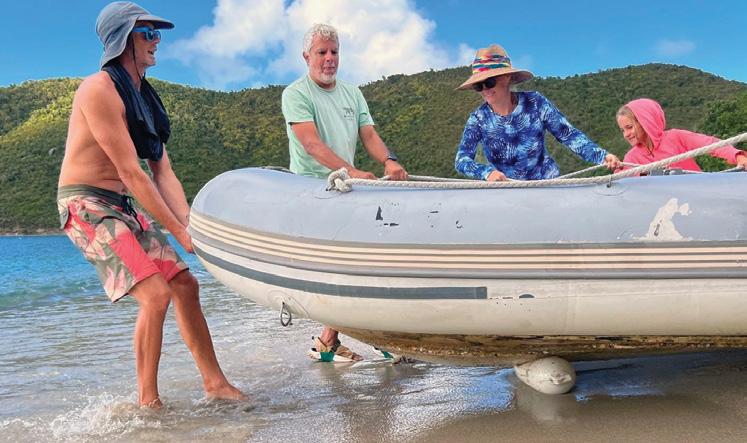
One obstacle we faced in St. John while in park waters was the rule that dinghies cannot anchor or tie off to trees or rocks. You can drag your dinghy ashore and drag it back into the water. That may work well for small charter dinghies, but our big ugly beast is a 10-foot, doublefloored RIB with a 25-hp, 4-stroke outboard. It’s a stretch for two adults to haul this thing up and down the beach. We struggled with it for a couple of days before another couple shared a solution with us: simple physics. We found a small fender and used it to roll the dink up and down the sand. It took a village the first couple of times we tried it, but once we got the hang of it, it became a life saver for getting ashore and still respecting park rules.
About the author: Chesapeake sailor and longtime SpinSheet columnist Cindy Wallach is on an extended family cruise with her husband, two children, and two dogs aboard their St. Francis 44 catamaran Majestic

I’m often asked about theft issues on charter, and frankly, my answer is that the risk of something happening out there is probably no worse than at home. Yes, there are places that are sketchier than others. In some parts of the Caribbean, you’ll want to lock your dinghy and motor to a dock with a chain, while you can pretty much leave your laptop on a dock in Tonga, and nobody will touch it.
The key is to ask the base before you leave about the risks of a particular cruising area. They don’t want their dinghy stolen either, so if they’re nonchalant about things, you can probably relax—to a point. Common sense is king. Check out our tips below for a more secure outing the next time you charter in some exotic locale or even in your own neck of the woods.

The best safety measure is prevention so lock the boat when you go ashore. If crew
By Zuzana Prochazkawill return at different times, hide the key in an agreed upon place aboard such as in the propane locker. To keep a bit of ventilation, open only small hatches that humans can’t get through such as the one in the head where it won’t matter even if it rains.
At night, keep a light on down in the cabins where it may seem as if someone’s home while you’re out to dinner. Lights in the saloon may just confirm that nobody is moving about, but lights down low may make a would-be intruder reconsider.
Small valuables, jewelry, electronic devices, and even passports can be hidden if you’re swimming to the beachside bar and aren’t taking them with you. Pillowcases and shoes make excellent hiding places as do provisions lockers. Don’t store everyone’s wallet or passport in the nav desk which is onestop-shopping for unwanted visitors.
Furthermore, flashy jewelry will attract attention ashore possibly making you a target. If you didn’t already leave it at home, hide it and don’t wear it off the boat.
If you want to have it in the morning, put it away at night. First off, secure the dinghy by bringing it up on davits at the end of the day. A thief will make more noise getting a dinghy down than just untying the painter. If there are no davits, try lifting the dink (even if just partially) with a spinnaker halyard.
Water toys such as standup paddleboards, kayaks, and floaties should be on deck and tucked away in the cockpit so that they can’t be reached easily and can’t blow away. Stow towels, shoes, and pool noodles while you’re at it. Swimsuits on the lifelines are generally safe, but stow them in case of rain so that you’re not wiggling into soggy bottoms the next morning.
# If you want to have it in the morning, put it away at night.
In very rare cases, boats have been boarded and people have been hurt. I sometimes sleep in the cockpit, but that’s more to hear what’s happening with the boat (such as a shifting anchor chain in a sketchy anchorage) than to thwart boarders. If the boat is closed up for the night (if the air conditioning is running), you can lock up, but otherwise, it’s not really feasible to sleep inside with everything sealed up. Drop anchor near other boats and keep your VHF radio on at night. If you’re really worried about a place, move. Otherwise, get a good night’s rest. Get
The coconut telegraph is highly efficient wherever cruisers and charterers gather. If in doubt, ask. Charter companies will advise you because they want their clients and their boats to be safe. Cruisers will share information, too, about where to go and where to skip. The rest is just a matter of preventive steps and common sense to make sure your stuff stays yours. #
About the author: Zuzana Prochazka is a freelance writer and photographer. A USCG 100 Ton Master, Zuzana has cruised, chartered, and captained vessels in many parts of the world and runs a flotilla charter company called Zescapes. She’s an international presenter on charter destinations, safety issues, and technical topics.

These sailboat charter companies specialize in sailing destinations such as the Chesapeake Bay, Northeast United States, Northwest United States, South America, Caribbean, Mediterranean, Southeast Asia, and South Pacific. Contact them and book your charter dream vacation today!

Loyal SpinSheet readers might recall the story of three classic wooden boats splashing down at Bert Jabin Yacht Yard five years ago after having completed a nearly 12,000-mile ocean voyage from Sydney, Australia, to Annapolis. The occasion was a series of challenge races between the historic Aussie Flying 18ers and the National Sailing Hall of Fame’s Bear and Bull Sandbaggers.
The contest was the brainchild of Sydney Flying Squadron historian Ian Smith who had run across the sandbaggers on a previous trip to the United States. He says, “Both styles of boats draw upon centuries of wooden boat building and classic rigging. Both are over-canvassed examples of how far boat designers will go to gain extra speed on the water.”
Smith hatched a plan to bring three of the squadron’s fleet of classic skiffs to the United States for a series of exhibition matches against the venerable sandbaggers. Twenty Aussies accompanied their boats and treated the locals to a lesson


in light-wind sailing they will not soon forget. Winning or losing was not the point of the three-day encounter. It was a fun time to form bonds between sailors that would last a lifetime.
Yours truly was one of the lucky Annapolis sailors who got a chance to sail aboard one of the 18ers. My ears still ring with the admonition “to get your bum over the side, you Yank… and don’t forget to pull up the skirt (lee cloth) to keep the water out of the boat. Bail. Bail. Bail!” The skipper of my boat was the grandfather of the Sydney fleet, John “Woody” Winning.
Woody and I have crossed paths several times over the past years as I have continued to keep in touch with my “Squaddie mate” every time I cross the Pacific to visit my daughter and her family in Sydney. Such was the case several weeks ago as I caught up with Woody and his pals at the Flying 18 Squadron’s annual fleet championship.
“I’m still picking crabs out of my teeth,” one of Woodie’s compatriots David Swales told me with a grin. “We could have used a little more wind when we were sailing on your Bay, but everything else about that trip was memorable right down to the local beer you served us and the heaps of steamed crabs we devoured at your house.”
I caught up with Woody just as his crew were rigging The Mistake, a 2005 edition of the 1933 original The Mistake which boldly carried the “2+2=5” insignia. The Squadron generally fields from six to eight boats every Saturday during the season. Woody Winning is the defacto benefactor of this and the modern Flying 18er fleet which sails on Sundays across the Harbor. His commitment to keeping the tradition of 18-foot skiffs sailing includes significant funding of both fleets for boat acquisition, repair, and rigging. 18er historian Frank Quealey credits Winning and his family for the ongoing
success of Australia’s iconic 130-year-old sport of 18-foot Skiff Racing on Sydney Harbor. “We owe much to the incredible actions and support of John ‘Woody’ Winning, the Winning family, and the Winning family’s business,” he says.

The 70-something Winning is a modest, self-effacing champion. He and his son John Winning have won individually and/or collectively every 18er skiff championship in Sydney as well as a host of international honors. The younger Winning has just been crowned season champion of the modern 18er fleet; Woody is very much in the running to take home the historic 18er Season trophy as well.
Recently the Winning father-son combination collaborated in bringing home one of Sydney’s most prestigious sailing honors: Line Honors of the Rolex Sydney to Hobart Race. The Winnings leased Comanche which the younger Winning skippered to a near-record breaking time of one day, 11 hours, and 56 minutes in the 77th running of the race in late December.
“Sailing that 100-foot maxi is really not much different than sailing one of these 18ers,” Woody told me with an impish grin. “In fact, keeping one these 18ers upright and sailing true is a little
trickier than hanging on as that maxi hit 40 knots downwind.” The Winnings paid a king’s ransom to lease Comanche for two years which will allow the boat to defend its line honors next year in the 78th Hobart. The boat carries the name Andoo Comanche, a nod to the boat’s historic past and the Winning’s successful on-line home furnishings appliance venture.
The race I witnessed, Race One of the Australian Championship, was contested on a crystal clear, blue skied afternoon in Sydney Harbor. Winds were gusting
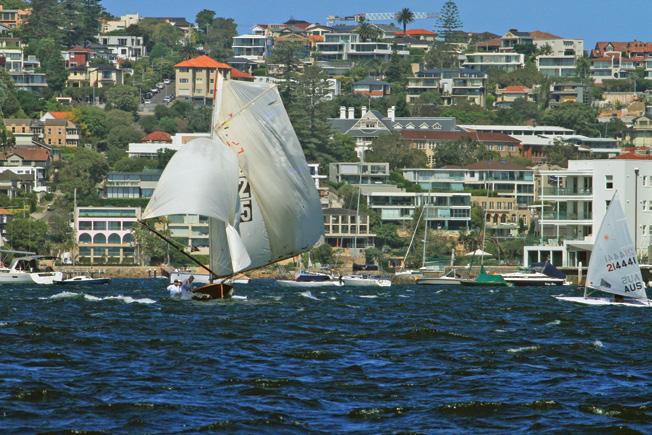
to 20 knots which resulted in most boats going with their smaller #3 rigs. Woody and his crew of The Mistake ran away with the day’s line honors, besting second place Yendy’s by three minutes.
“We had to make some repairs while underway,” Winning said with a laugh. “All’s well that ends well.” The crew even set their ringtail (an extension to the main that adds another 10 percent of sail area to the rig) as they approached the finish line.
Attention Chesapeake Bay sailing clubs: share your club news and events in SpinSheet’s Club Notes section by sending a 350-word write-up and one or more clear photos of smiling faces or pretty boats to beth@spinsheet.com. Thanks to Club Notes section sponsor, YaZu Yachting! Find them at yazuyachting.com and on Facebook.


So, I just got back from a bareboat cruise in La Paz, Mexico… ahhh the beauty of the Sea of Cortez. I am so glad to be a member of Singles on Sailboats for a variety of reasons, one of which is the amazing bareboat program. Last fall was Sicily; this winter La Paz, and now I am answering a survey from the bareboat committee about where we might plan to go next.

In the meantime, I am looking forward to this summer’s cruising. Already we are planning for an extended cruise on the Chesapeake in May starting from the Wye River and working our way up to Chesapeake City on the C&D Canal. My summer plans are interspersed with day sails all around the Bay and several weekend cruises. Sometimes we will raft up in a beautiful little river. Other times we will hop into a marina slip for a shore party with food and dancing.
Before I get the sails unfurled, I am working through my safety and review opportunities. I just finished a full-day CPR training class with
the Annapolis Fire Department, and I will sign up for the all-day Spring Training seminar that SOS hosts on April 1. It includes a choice of 30 informational sessions. At the end of April, I will go to a morning of flare and safety activities that includes practice putting out fires with extinguishers and blankets, shooting flares, throwing a line, digging in an anchor, and safely wrapping a line around a winch. That will be followed
by an afternoon of dockside training where I will be assigned to a skipper’s boat to go over features, safety, nautical terms and actions, and maybe even take a quick sail.
Well, I just got that email blast I was waiting for from the club about the bareboat cruise this fall: San Juan Islands off the coast of Seattle, WA. I’m signing up! How about you?
Learn more at: singlesonsailboats.org


From the last Friday in May through the last Friday in September, Yacht Club Cape St Claire (YCCSC) organizes friendly Friday Night Races on the Magothy River.

These races are geared to cruisers; that is, we want to keep a laid-back attitude. They are tailored to the beginning or casual racer. We also want to keep it easy, so headsail changes are not allowed (in particular, no spinnaker). There is no need to know about racing rules (we just want to have fun; lowkey is the word!), and we do not entertain protests. Couples, parents with children, and friends come out to try their hands at rounding the buoys in some semblance of order. It is a wonderful way to get out on your boat, enjoy a sunset, shake the work week out of your system, and maybe earn some bragging rights on the way.

Every boat is different (so we use handicaps based on the PHRF system to make


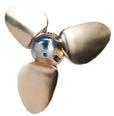
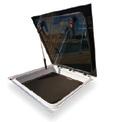
it more equal), from an 18-foot pocket cruiser to a 40-plus-foot cruising yacht. We even have an occasional Hobie 16 or other dinghy enter the race. The goal is not so much to win, as it is to have another reason to go sail with our friends of the yacht club.
There is no cost to YCCSC members (including MRSA and GYIS). Non-members may join YCCSC with membership dues of $45 (application is on the website). Directions are included

in the Committee Boat Information document on the Friday Night Racing page of our website, capeyachtclub.org Races start at 7 p.m. (6:30 p.m. in September) and last typically one hour. So, join us on Friday nights! Just show up, find the Race Committee boat (flying a “RC” flag). Check-in with the Race Committee, find out about the course, and get ready for the start. The results are published weekly on this website.

The Sailing Club’s board of trustees has been busy preparing for the 2023 sailing season. Our new year starts April 1. As a bareboat chartering club,


we can sail anywhere in the world that we can charter boats.
On the schedule, which is still growing, is a mix of local and distant destinations. We start the season off
with some virtual training events and a CPR class on April 1.
The annual On Water Training weekend will be May 20-21. The weekend is a busy schedule of hands-on boating safety rules, line handling, basic knots, as well as practice in reversing, raftup techniques, and backing into a slip.
June’s trip will be a weeklong Southern Bay trip sailing out of Solomons Island June 9 to 16 to enjoy the unique charms of places like Tangier Island and Smith Creek.
In July we’re looking to renew one of our favorite social events: a day sail on Barnegat Bay. No dates set yet, but it’s being worked on.
August’s trip is not our typical trip. We have chartered three canal boats and are planning to explore the Erie Canal heading West from Macedon, NY, toward Rochester and a little beyond. Stopping each evening in a town will allow time for a restaurant meal, and going through the locks each day will provide valuable experience for anyone considering a European narrow boat trip.
September’s offering is sailing out of Anacortes, WA, among the San Juan Islands. The float plan includes stops at Lopez Island, San Juan Island, and Orcas Island, and a few others.
The Winter Escape trip is still being planned; however, the trip leaders are leaning heavily towards Antigua and Barbuda for February 2024. This most easterly of the Windward Islands, promises great sailing, as well as calm anchorages within well protected reefs.
We look forward to meeting new people as we explore; perhaps you could be one? Check us out at thesailingclub.org.

With the mild winter we’ve been experiencing and spring right around the corner, thoughts of boating season are starting to creep into our heads. With most of their boats still laid up for winter, Back Creek Yacht Club members have been making the best of the off-season with other activities while awaiting the opportunity to “splash” for that spring shakedown cruise.
The club recently held its annual Chili Cook-Off at the Epping Forest Clubhouse in Annapolis, and the event was well attended. There were several different batches of chili entered in the competition which included beef, chicken, and vegan options. These were voted on by attendees, and a “Best Chili” chef’s hat was awarded to the winner.

Farther south, our Florida contingent of snowbirds have been busy as well. A Super Bowl party was held in Stuart, FL, with two rooms decorated, one in red and one in green so fans of the respective teams could feel right at home.
We held St. Patrick’s Day celebrations in both Maryland and Florida and have a calendar with a full slate of events (both land and on water) planned for the 2023 season. Parties interested in joining the fun should visit backcreekyc.org for more information.

CHESSS has had a busy winter and is moving with deliberate haste to the sailing season ahead. The winter began with CHESSS’s Winter Membership Meeting, which included a presentation by Peter Kleim on his doublehanded trans-Atlantic passage. New this winter, CHESSS has held monthly Sip-And-Sups so our gregarious loners can get together and chat. The club wrapped up the winter social season with a well-attended lecture by Cody Ledbetter from NOAA followed by a panel discussion with Cody, Randy Richter from CBYRA, and Jeff Halpern from CHESSS on Chesapeake Bay Weather: Shorthanded Strategies in Changing Conditions.
Our first on-the-water event will be the May 6 Gather-and Gab (G&G) Raftup and Member Meeting. After eight years with his steady hand on the tiller, founding commodore Rich Acuti will


step down. Vice commodore Doug Ellmore will don Rich’s epaulets. The G&G raftup will be preceded by practice shorthanded racing starts out in the river.

For the racers, CHESSS plans an active racing season with six CBYRA High Point starts, the first of which will be the April 29 NASS Race to the Lighthouses. That will be followed by the May 13 AYC Spring



Race to Oxford and the May 20 everpopular Poplar Island Race. The HHSA Shorthanded Race, the NASS Fall Race to Oxford, and CHESSS Last Hurrah will wrap up the high-point series. Four additional CHESSS non-High Point starts are also anticipated.

Planning for this summer’s cruises is also well under way. For more information, please visit: chesss.clubexpress.com
All committees of The Corinthians Chesapeake Bay Fleet have been working throughout the winter to prepare for a stellar 2023 sailing season. We have at least one event per month for members, guests, and prospective members in which to participate. Kudos to Janice Cannon and committee for putting together such a robust schedule!

Twenty-seven members and guests attended a wonderful luncheon March 4 with an educational session on Good Seamanship, May Day protocols, and technology updates. Willing participants were tested on their boating acumen. Many thanks to Coast Guard Auxiliary boating experts Adam Yearwood, Jim Farrell, and Dave Sire for a job well done.
Our first “on water” event will be held April 22-24 in the West River. This annual event is aptly named “The Non-Procrastinator” for those who get a jump on the season (or thought they did but didn’t). It is a safe boat event since there are plenty of people around to help out if everything on your boat isn’t quite 100 percent yet. We often have sailboats without sails motoring to the event, some rafting or taking a slip since they haven’t attached their anchor yet, and others just meeting on land who procrastinated just a little too long. All in all, a fun time with good friends, old and new.
The calendar has two events in May: a Shakedown Mini-Cruise and a multiclub event over the Memorial Day weekend on the Wye River, organized by CB Fleet members and the Eastport Yacht
 By Susan Theuns
By Susan Theuns
Club. Our Spring Cruise will be held June 10. This year’s theme is Living is Easy and Hopefully Breezy Northern Bay Cruise. As the theme implies, we are headed north after our start from Conquest Beach. Since members’ home ports range from south of Annapolis to the Bohemia River, participants can “jump in” or drive-along to the
various venues. Members should check the website for details about ports and activities (an Orioles Baseball game is on the itinerary).
Want to learn about our organization? For information, please check thecorinthians.org and view or download a membership brochure.
As of this writing in early March, sailing on the Chesapeake seems like a distant dream. But it is never too early to start planning for the upcoming season. April is planning month and members will be meeting in Annapolis to do just that.




The scheduled planning date is Saturday, April 8 at the Capital Yacht Club, in Annapolis, hosted by yacht club members Mario Taisch and Lori Burkhart. This annual event will be held from 1 to 4 p.m. followed by a BYOB cocktail hour. During this annual meeting members will establish their monthly meet-ups with hosts volunteering to set up these get-togethers. As in the past, members arrange a monthly social time and often a raftup on the water in a place designated by the host boat.
In addition to the monthly planning this year, we will discuss the DelMarVa Loop that is currently planned for Saturday, May 20 through Thursday, May 25. Larry Kaufman will spearhead this event and will speak about this adventure for those who may be interested in joining the cruise.
In addition to planning, the annual meeting will offer a program of interest to members. This year’s program is still being determined. If you are new to JSO or a new Jeanneau sailboat owner and would like to join us, please contact Paul and Karen Novack at svopiebea@gmail. com. We welcome new members!

JSO is a loosely formed group of Jeanneau owners who enjoy boating and socializing together. See our website at groups.io/g/JSOChesapeakeBay.







For the February Founder’s Day Social members of America’s Boating Club Wilmington (ABCW), aka Wilmington Sail and Power Squadron, enjoyed some socializing and some friendly Super Bowl posturing. A highlight of the gathering included a special presentation by Dr. John Broadwater on the background, history, and ultimate recovery of the USS Monitor, one of the civil war ironclads that changed the nature of naval warfare.
Dr. Broadwater opened with a brief history of the design and background of the Monitor and her battle with the South’s Merrimack (CSS Virginia) and the ultimate loss of both ships. He described the discovery of the wreck of the Monitor in the Atlantic.
Dr. Broadwater was intimately connected with the recovery of key parts of the ship. He continued with a description of the condition of the wreck and explanations of several of the methods developed and used (many for the first time) in the recovery of the artifacts, such as saturation diving and the use of grout bags and some really big cranes. He finished with a description of the steps of conservation and the current state of the artifacts, and where you can see them at the USS Monitor Center at the Mariner’s Museum in Newport News, VA. Dr. Broadwater is also the author of USS Monitor: A Historic Ship Completes its Final Voyage which goes into much more detail of the story.

At the beginning of Safe Boating Week on Saturday, May 20 ABCW will offer Vessel Safety Checks at North Point Marina, Bayside Landing, and Osprey Point Marina in Rock Hall from 10 a.m. to 3 p.m. A boaters’ flea market will also be held at North Point Marina. Come join us! Learn more at wilmingtonpowersquadron.org.


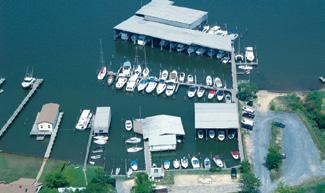



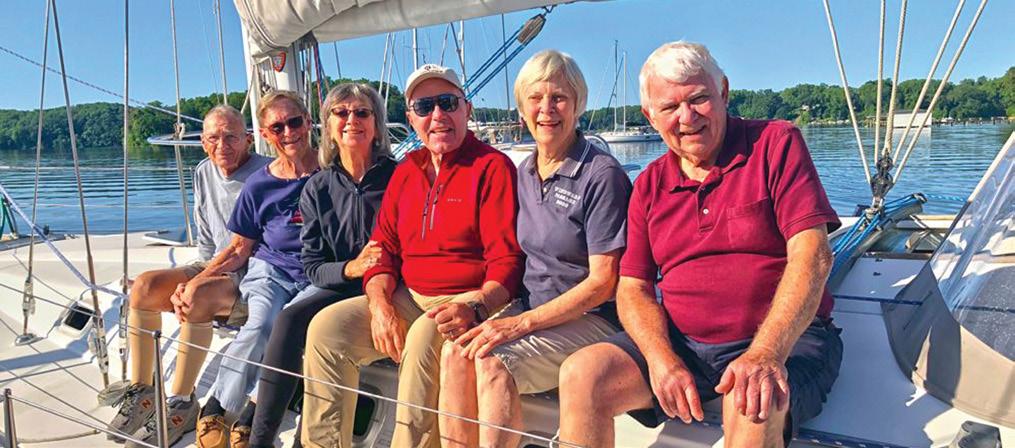


The Hunter Sailing Association Station #1 kicked off 2023 with our February 25 brunch at Federal House in Annapolis. During the brunch club officers outlined our plans for the 2023 sailing season.

In addition to planning the brunch, vice commodore Celeste Streger mentioned our upcoming virtual happy hour with Gary Jobson. He served as tactician on the winning America’s Cup yacht, Courageous, in 1977, with skipper Ted Turner. He competed in over 5800 races and is the author of 21 books on sailing. Fleet Captain Jeremey Midgley discussed our preliminary 2023 sailing schedule. More than 15 events are planned including a Hunter Rendezvous and a DelMarVa rounding.
Commodore Laurie Underwood spoke about the 2023 Hunter Rendezvous: Celebrating 50 Years of Hunter Sailing, which will take place June 15-18 at the Harbor East Marina in Baltimore. Our
keynote luncheon features Glenn Henderson and Rob Mazza, who are responsible for designing numerous Hunter models over the past five decades. The event also features experts from Quantum Sails, the Chesapeake Bay Maritime Museum, the U.S. Coast Guard, and much more. The weekend includes two evenings of live entertainment including a gourmet dinner with open bar featuring Wheelhouse Rock Band, voted the best band on the Eastern Shore three years in a row. We will also have a cocktail and dessert reception featuring a duo from Starcrush, one of the premier party bands in Baltimore, rum tasting, a beer and pizza party, children’s activities, and much more. We welcome Hunter owners from across the country to join us for this momentous event. Additional details and event registration can be found at: hunterrendezvous.com
Following the rendezvous, HSA-1 members Carl and Sue Reitz will host a weeklong cruise from Baltimore that will culminate in a raftup in Reed Creek off the Chester River to celebrate the Summer Sailstice, the international celebration of sailing.
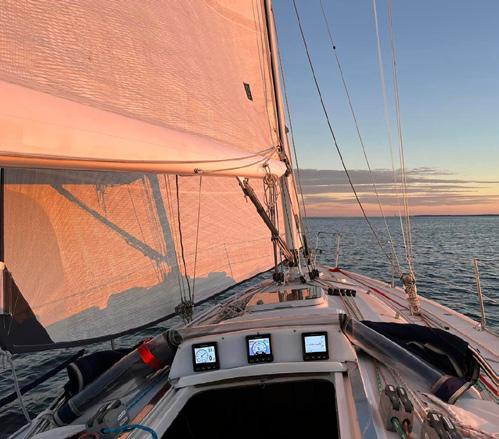

If you have a Hunter in the mid-Chesapeake Bay and are not a member, please check out our club at hsa1.org or email commodore@hsa1. org to learn more about the benefits of membership, which includes access to all club cruises and events and a direct connection to a network of Bay Hunter owners.
Presented by

Picture this: you’re a casual cruiser, weekend daysailor, or have recently acquired your first ASA or US Sailing certification. You’ve just been invited to race on a new boat… now what?

For insight on what makes a great racing crew, I spoke with active racers
Ashley Love, editor in chief of T2PTV; Stephanie Sweeney, sales manager at Evolution Sails Hampton; and Lauren DeSimone, crew training coordinator at Fishing Bay Yacht Club.
What should crew members bring to a race?

Ashley: Bring something to share, whether that’s a 360 camera, a six-pack of beer, the weather or tide forecast, a killer joke, the newest navigation app, whatever speaks to your personality.

Stephanie: Gloves, deck shoes, and White Claws. Bring only what you need to be comfortable. Leave everything else in the car.
Lauren: Curiosity, jovial spirit, and beverages or snacks to share. You can’t




go wrong with keeping at least these things in your sailing bag, some of which you can stow below deck or leave in your car: closed-toe non-scuffing shoes, sunglasses, hat, rain jacket, bathing suit, sunscreen, ChapStick, water, sailing gloves, PFD, change of clothes, and medications.
What should crew never bring to a race?
Ashley: Hard-sided luggage, shoes with marking soles, glass anything, unannounced guests, and weap-


Presented By: Join Us
February 25: Rigging, Sails, Sail Prep & Repair Kits - Recorded
april 6, 6pm-8pm: Safety Equipment for Vessel & Crew
april 18, 10am-12pm: Medical Aid at Sea & What to Include in Your Offshore First Aid Kit
May TBD: Navigation, Routing, & Weather Forecasting
Seminar registration is available on annapolisnewportrace.com/seminars
Wed. May 31 & Thurs. June 1: On-Site Registration
Thurs. June 1: Pre-Race Reception @ Annapolis Yacht Club


Fri. June 2: Start #1 • Sat. June 3: Start #2
Questions? Email info@annapolisnewportrace.com
ons—unless it’s a super soaker and it’s 100 degrees outside!

Stephanie: Don’t bring foulies on a 90-degree, light-wind, sunny day. Don’t bring extras of anything you do not need.
Lauren: An unwillingness to help out however and wherever is needed.
What should crew do before a race to prepare?

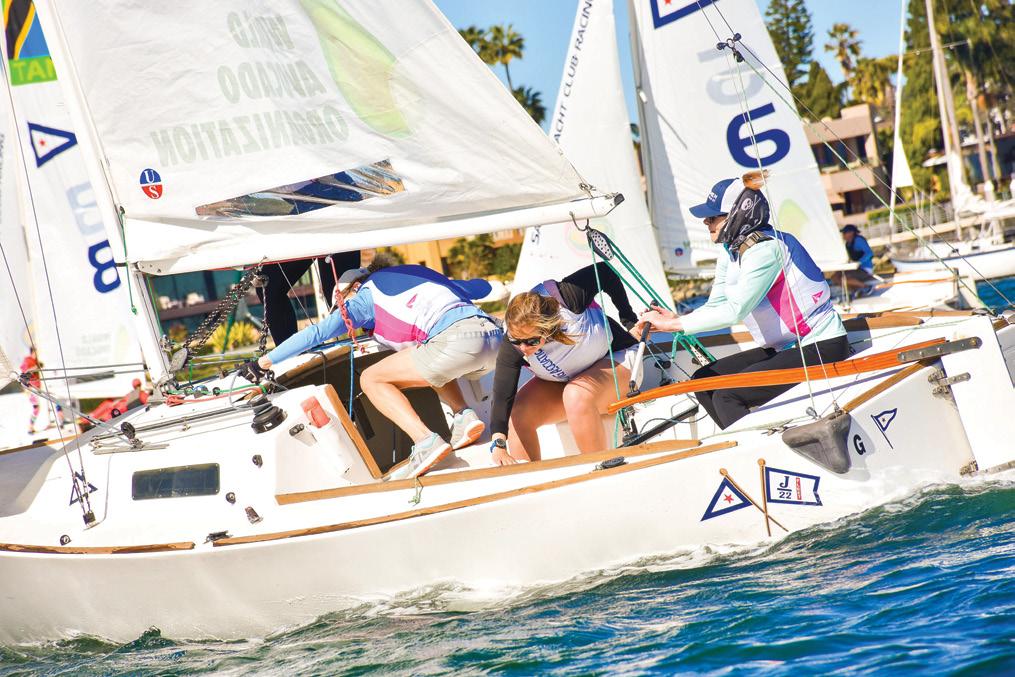
Ashley: Be ready to play! Get a good night’s sleep, eat the foods that make you feel good while being active (not every food “sits” well!), be sober (well... you know what I mean). Take the time to stay in the physical shape that will be
required to perform. Study up on your position. Learn the rules and strategy as best as you can. Talk to the people who race the boat regularly to develop rapport. Learn what is expected and not expected of you. A positive attitude can go a long way.
Stephanie: Chill the White Claws; no one likes them warm! Familiarize yourself with where the clutches are, any trip hazards, anything different from the last boat you sailed on so you know where stuff is.
Lauren: Ask the skipper if there’s anything you can bring and if there is any work needed to get the boat ready. Confirm the dock time and departure time. Arrive on time or early, and absolutely 100 percent: do not say you’ll race and then not show up.
Please join us for the 3rd annual EWE Spirit Cup Regatta hosted by the Sailing Club of the Chesapeake



This fun pursuit-style race is open to any sailing vessel. Anyone looking to Sail Like EWE and live like EWE should register to sail, fundraise, and join in the post-racing fun. There will be awards for the top fundraising individual and team plus special Forward Brewing beer for all race finishers. Any individual who raises at least $100 for the foundation will receive a EWE Spirit Cup tech shirt from our sponsor, Team One Newport.


ewespirit.org/ewe-spirit-cup

How can new crew members be most helpful, especially if they don’t have a designated role?
Ashley: Don’t be afraid to make mistakes; just try to not make the same mistake again. Take mental notes (or real notes) to bring up in a debrief later to ask questions. Join the comms team: point out relatives (your speed relative to other boats around you), puffs, geographical features, waves and bad chop, or what the rest of the fleet is doing around a mark. If you’re not on the comms team, stay quiet. Cross the boat with gusto! Everyone on the boat is ballast—look and listen for cues on what the boat wants and aim to help maintain that angle of heel.
Stephanie: Pass out the White Claws! There is a job for everyone on the boat, and you can create your own job. Sit in the middle and pay attention to boat controls. Take notes if things like the outhaul or halyards are eased in a downwind run and not reset after a mark rounding—speak up and point out that settings need to be changed. Offer to lean against the boom when sailing downwind. If you know how to call wind shifts, do it!
Lauren: Keep an eye on all the lines and always ensure they’re ready to run, i.e. no knots, tangles, or precarious loops. Grab snacks and drinks from below. Be curious and ask questions—but maybe not in the midst of intense racing.
What should crew never do while racing?
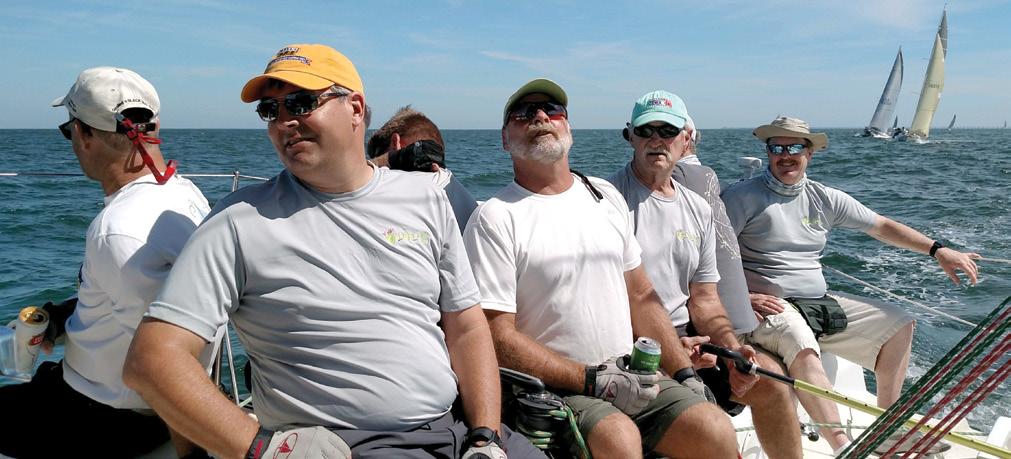
Ashley: Never cheat, yell at people on your boat or others, put anyone in a dangerous situation, jump off the boat (unless you’re racing in a Pacific island where that’s your role to do so before the last downwind leg!). Don’t use a phone for any reason during a race (it’s distracting and could be considered “outside assistance”), blame things on other people that are your fault, or assume anything about your role without finding out.
Stephanie: Not share the White Claws! Don’t drag your feet in the water, and don’t drop anything off the side of the boat. All bottles and beers need to stay on the boat, empty or full. Lauren: Never presume you know more about racing than other crew or presume the owner of the boat doesn’t know what they’re talking about. Never disrespect the skipper, boat, crew, or weather.
What should crew do after the race?
Ashley: If the tactician or crew boss has a debrief, be ready to contribute something positive and something you need help with. Also offer up the question to the entire crew: “What can I do to make your job easier?”
Stephanie: Drink the White Claws! Everyone should pitch in to clean up the boat and put things away. Clean up trash and offer to carry the bag to a trash can.
Lauren: Take down all sheets and sails per skipper request, lay out anything that needs to dry, and thank the skipper and the rest of the crew for their company.

Ashley: Every time you step onto a boat, you’re building or crashing your reputation. Crew bosses and skippers will pick positive, prompt, and prepared people who are willing to learn and work hard over the most skilled person who has proven themselves untrustworthy.
Stephanie: Some of the crews who are mixed with kids, women, and men are the best teams on the Bay. Do not discount someone (or yourself) for their size, strength, or age. Everyone has something to contribute.
Lauren: It’s okay to ask a ton of questions. Try crewing on different boats; they all have different functions and cultures. And what happens on the water stays on the water rain or shine, win or lose, we’re friends and family back on land. #
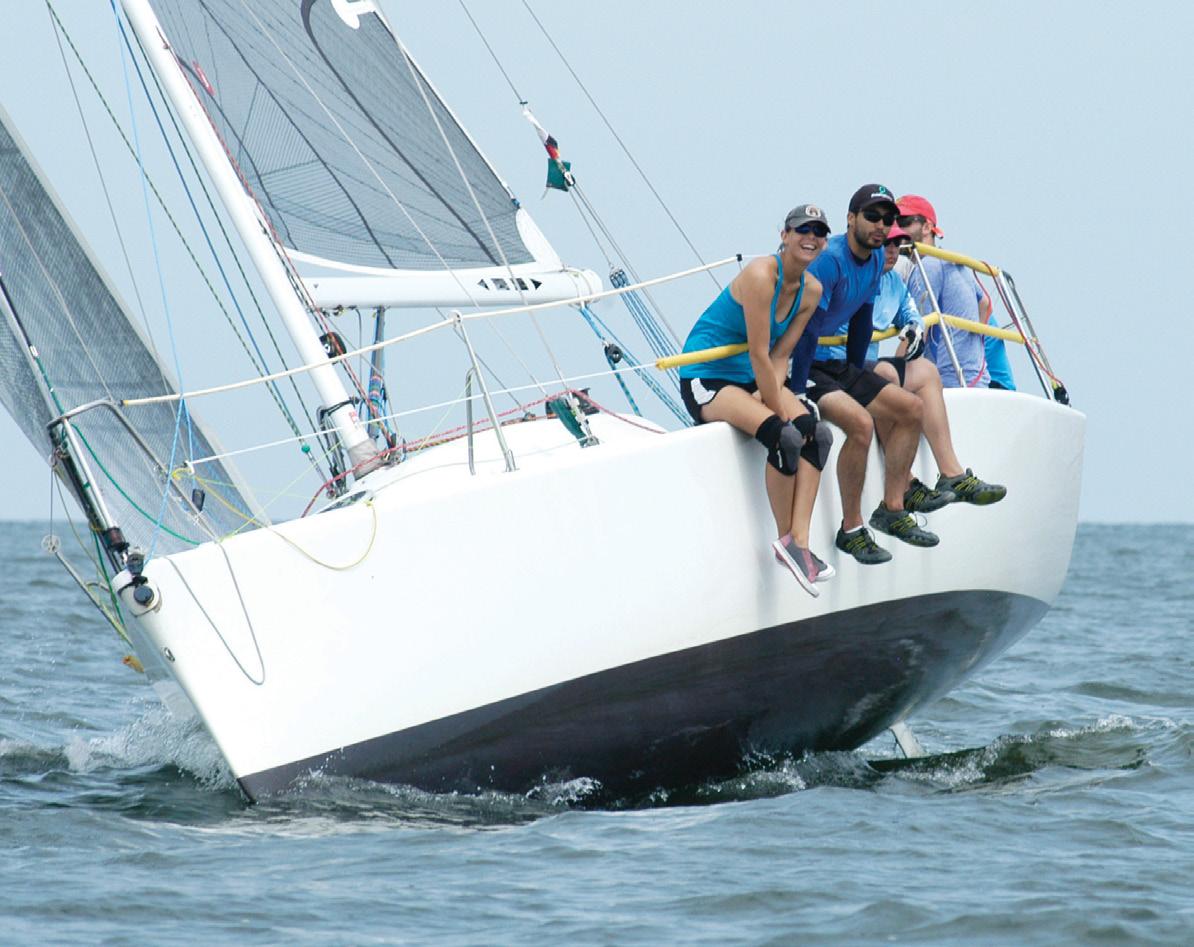












The town of Mount Pleasant and City of Charleston are rightfully proud of the grand prix sailboat racing regatta that has become a fixture of the region. Charleston Race Week has brought a huge economic boost to both municipalities for more than a quarter of a century.
When longtime event director Randy Draftz determined that Charleston Race Week needed a new venue, he reached out to Mount Pleasant mayor Will Haynie. Mayor Haynie, an ardent supporter of the regatta, quickly sprang into action. He picked up the phone and dialed Mac Burdette, executive director of Patriots Point Development Authority.
“Will Haynie called and asked if there was anything Patriots Point could do so the regatta could remain at its traditional home,” Burdette said.
“Charleston Race Week is very important to Patriots Point. We appreciate what this event does for our town and region,” Burdette said. “Our goal is that the aircraft carrier will become the home of Charleston Race Week for many years to come.”
So it was that a deal was struck for Charleston Race Week to move its Race Village onto the USS Yorktown, the historic World War II era aircraft carrier that is berthed at Patriots Point.
Draftz is excited about the new venue and believes regatta participants will enjoy attending post-race parties aboard a floating museum that has been designated as a National Historic Landmark.
“The USS Yorktown is an iconic warship and a landmark feature along the
Charleston Harbor waterfront,” Draftz said. “It is one of the most popular tourist attractions in the area and a unique venue.”
USS Yorktown is an Essex-class aircraft carrier commissioned in April 1943. Initially to be christened as the Bonhomme Richard, she was renamed while still under construction at Newport News Shipbuilding and Drydock Company. It replaced the USS Yorktown that was sunk during the Battle of Midway as U.S. Navy officials hoped the Japanese would think the original carrier was salvaged.
The USS Yorktown was decommissioned in 1970. Five years later, it was transformed into a museum ship at Patriots Point in Mount Pleasant. Burdette noted that fast sailing vessels such as clip-
pers, frigates, and schooners were used for maritime military operations.

“I think there is a natural connection between this regatta and our mission,” he said. “I would expect that a lot of the people participating in Charleston Race Week are interested in military history. Hopefully, being aboard the Yorktown will make the event more meaningful for them.”
This won’t be the first time the USS Yorktown has been used as headquarters for a sailing regatta. When College of Charleston hosted the collegiate national championships in 2017, all operations were held aboard the aircraft carrier.

Charleston Race Week will conduct the Quantum Sails daily racing debrief aboard the Yorktown. Hangar Bay Three, which is where all the fighter jets were armed, repaired, and protected, will serve as location for the nightly parties.
Sailors will be allowed to go up to the flight deck to watch Saturday night’s popular Pro-Am Regatta, which pairs prominent professional sailors with high school students from the greater Charleston area. Both the flight deck and fantail, which are 67 feet above the water, offer a spectacular view of Charleston Harbor and the city skyline.



All the evening parties will feature southern-style small plates prepared by Southern Bear Catering, which was just voted best caterer by readers of Mount Pleasant Magazine. Of course, there will be the traditional Dark-N-Stormies made with Gosling’s Rum and craft beers from Plankowner Brewery. As always, daily racing highlights will be streamed on a large screen aboard the USS Yorktown
The 27th annual Charleston Race Week will be held April 20-23 with close to 200 boats in 20 classes competing. Quantum Sails returns for its 10th straight year as the Official Sailmaker of Charleston Race Week and will once again be supporting sailors with service, resources, and expertise. Quantum Sails provides educational opportunities with its morning weather and local knowledge briefings, providing competitors the information needed to tackle the tricky breeze
and fast-moving current of Charleston Harbor.
Skippers planning to participate in Charleston Race Week should reach out to a Quantum representative to make sure their sails are up to speed for the threeday regatta.

B&G will once again be on site for service and have their latest instruments on display, while Team One Newport will have a tent filled with all sorts of great gear for the 2023 sailing season.

“We are very fortunate to partner with many loyal sponsors that bring great value to the event,” Draftz said.
This year’s regatta will feature several new classes, including the Hobie 33. That one-design class will be contesting its national championship in conjunction with race week and a strong fleet is expected.
Charters are available for those sailors looking to check Charleston Race Week off their bucket list without having to bring their own boat. There are already eight entries in the RS21 one-design class, and RS Sailing has more of the keelboats
to offer. College of Charleston has a fleet of J/22 racers ready to launch.
Returning to Charleston Race Week after making a breathtaking debut in 2022 are the cutting-edge 69F foiling catamarans. Sailors interested in learning about foiling can put together a team and race these high-tech racers, which will glide across Charleston Harbor at heart-pumping speeds.
Convenient launching and hauling will be provided at James Island Yacht Club, Charleston Yacht Club, and Cooper River Boatyard, the latter of which offers special rates for race week participants. Dockage options also include Charleston Harbor Marina and Resort, Safe Harbor City Marina, and College of Charleston. Boats being transported from the various winter regattas in Florida can utilize the storage facility at East Coast Hydraulics, which offers a fenced-in yard with reasonable rates.
Learn more at: charlestonraceweek.com.

For the 2023 Bacardi Cup in Miami, FL, March 5-11, 168 sailing teams registered to compete on Biscayne Bay in six classes, including Star, J/70, Melges 24, VX One, 69F, and Melges 15. The event is known for attracting top talent, including Olympians and World Champions. Annapolis sailor Henry Filter and his team on the J/70 Wild Child sailed into first place in the Corinthian Division.

Filter had only competed in the Bacardi Cup one time in the Star Class in 2008. This was his first time there in the J/70 yet not his only J/70 regatta this winter. He’d also sailed in J/70 Bacardi Winter Series 1 and 2 and the Helly Hansen Sailing World Regatta Series in St. Petersburg, FL.
Filter says, “The breeze was in the light-to-moderate category with average in the eight- to 10-knot knot range over the course of the regatta.”

Annapolis sailors Alex Stout, Will Wagner, and Tom Murray rounded out the Wild Child team.
When it comes to teamwork, the skipper says, “We continued to fight hard and never gave up. The competition was fierce with the majority of boats utilizing professional crew. The skill level in nearly every boat was some of the best talent in the world.”
The parties weren’t bad, either. “Sponsored by Bacardi Rum, the cocktail parties and dinners were excellent as was the awards ceremony on Saturday night.”
Filter is pleased with the team’s overall performance. He says, “The entire winter will be a memorable one, as we have gotten better and better with the passing of each regatta in Florida since last December. We have one more event to go in two weeks; the J/70 Midwinter Championships have 62 boats registered. It will be three days of intense top-level sailing.”
What’s to love about this event? Filter says, “It’s all about the sailing. There is no better place to sail in March than Biscayne Bay. The conditions are awesome!”
About the future, he says, “We are training for the Worlds in St. Pete, FL, next October, so we have a busy spring with the J/70 Midwinters (in Miami), Charleston Race Week in April, and the Helly Hansen Sailing World Regatta –Annapolis in May. After that, we will do a lot of local racing and practice in Annapolis to prepare for the Worlds.”
Among other Chesapeake sailors on the race course at the Bacardi Cup were Bert Collins and James Golden on the Star Grinch, Matthew Rajacich and Eric Wagner on the Star Manipulator, and Paul Murphy and Dirk Schwenk on the VX One A 5-0-5 for Old(er) People Learn more at bacardiinvitational.com
 By Hannes Leonard
By Hannes Leonard
Blue skies, blue water, steady breeze: what better way for a Chesapeake race crew to reunite after several years of separation? The Royal Ocean Racing Club’s Caribbean 600 and the welcoming hospitality of Antigua provided the perfect opportunity for five Annapolis-area sailors to meet up for a few days of sailing and fun.
Ted Lepich, Sean Reilly, and Denis Hope-Ross joined my dad Greg Leonard and me to race for three days aboard our Class40 Kite. Ten years ago, I learned to race with this crew aboard my family’s J/120 Heron. I loved sailing in classic Chesapeake races such as the Down the Bay Race and the Governor’s Cup. Now, we would all race together again in the tropics.
Renowned for its challenging course, the Royal Ocean Racing Club’s Caribbean 600 stretches approximately 600 miles through the northeastern Carib-
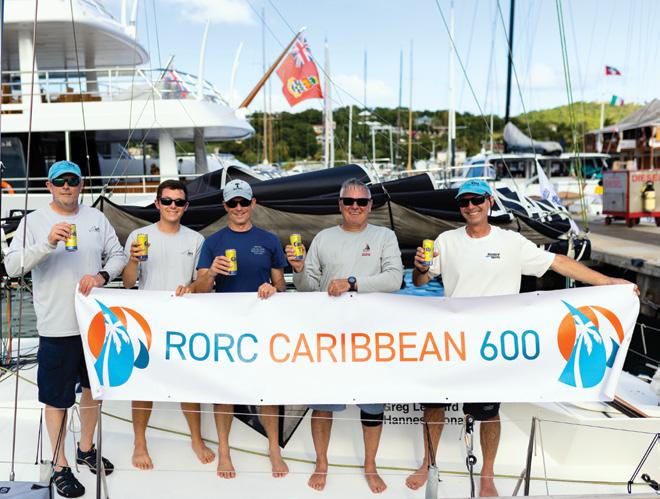

bean. After three years of Class40 racing in Europe, my dad and I were looking forward to the promise of warm weather and trade winds that Caribbean sailing brings. Following the transatlantic Route du Rhum, this year’s race featured a particularly good showing of Class 40s with 13 boats lining up to start, including seven of the recently designed “scowbow” boats (which are significantly faster off the wind).
From the outset, the intensity of the racing stood out. The multihull class line honors were decided by 11 seconds. With most of the Class40 fleet raced by professional crews, the competition was unrelenting. The race course contained frequent turns, making it a challenge to settle in and requiring constant attention and frequent sail changes. The course felt much more like 12 back-to-back Chesapeake Bay distance races than an offshore
race. The many short legs meant that it was particularly challenging to find time to rest and eat. An added challenge was the impact of the high, volcanic islands on the wind. Some islands blocked the wind completely, resulting in zones of extremely light air, while the wind funneled around others, resulting in strange wind angles and strong gusts.
After beating up the south coast of Antigua following the start, we got a full set of conditions to test our prowess. Beats changed to downwind legs which changed to reaches and back again. Class 40 sailing is technical, necessitating a lot of sail changes with extra steps compared to a traditional race boat. With every maneuver came a slew of tasks above and below deck. From moving hundreds of kilos of gear around to hauling the next sail on deck, this amounted to a strenuous workout that never let up. Denis described the feelings of the crew
towards sailing the Class40, saying, “The French have been developing the ultimate torture machine, and with the Class40, they have very nearly perfected it.” No wonder we were ready for burgers and beer at the finish line.
The rounding of Guadeloupe proved especially challenging for us. After having a relatively easy escape from the notoriously challenging wind shadow in the lee of Basse Terre, we were sailing steadily just east of Les Saintes, the most southerly point of the course, when we caught a fish-attracting device on our keel. These devices consist of hundreds of meters of plastic line with rocks and shells tied to it that local fishermen use to attract fish. As we learned the hard way, they are often only marked by a small float, often in the form of an empty bottle.
Unfortunately, our attempts to back down and sail free of the lines only resulted in putting more wraps around the keel and rudders. After about an

hour of drifting, we were able to cut all of the lines free except a 30-foot piece that had carved a four-inch groove in the keel. Freeing this required sailing into the lee of Marie-Galante where it was calm enough to dive on the keel and remove the line. This adventure completed, we set off north to round Le Desirade and continue towards Barbuda.
With 75 hours and 600-plus miles behind us, we happily crossed the finish line. A lovely welcome party met us at the dock with a case of beer. Post-race celebrations ensued. Later in the week, the RORC hosted a fun-filled awards party, and our crew had a great time reliving old stories and enjoying the charms of Antigua.
About the author: Having grown up racing, cruising, and living aboard on the Chesapeake, 19-year-old Hannes Leonard now races aboard the Class40 Kite with his dad, Greg.


Annapolis native, 49er sailor & Olympic Development Team Member casey cabot is the full-circle Oakcliff competitor. He trains, races, fixes boats* and coaches at oakcliff, all critical steps in his quest for the Olympics. “We even learn through disasters. At a bottom mark a competitor took out a large chunk of our wing. The Oakcliff pit team helped us replace and later fix* it. we are happy to work hard for our goals and oakcliff helps show us the way!”
Casey has earned over $12,000 in prize grants at Oakcliff’s Triple Crown Regattas providing critical funds for his quest which includes campaigning for the 2024 Olympics, shooting for the LA games and a successful professional career after. Oakcliff hopes to see their HP beach full of Skiff, 470, Nacra and ILCA sailors this summer.



Any centennial celebration is likely to be a one-time affair for most of us. This summer marks the 100th year of Star boats on the Chesapeake, specifically at Gibson Island. The Gibson Island Yacht Squadron (GIYS) will host the Annual J Rulon Miller Series for Stars on June 23-25 which will be the District 2 Championships, the Miller Series, plus a long distance race on Friday.
The Gibson Island club, which has twice hosted the Star Internationals (1930, 1951), will host the celebration as only that club can do, as a whole island event with a barbeque party hosted by the long-time Star-sailing Dunigan family on Friday evening followed by a clubhouse outdoor party after racing on Saturday. Racing on Saturday and Sunday will constitute the District 2 Championships.
Entries are expected from throughout the East Coast and both sides of the Chesapeake. The three days of racing will be conducted by Greg Cukor and well supported by Squadron members. The distance race on Friday memorializes the annual Star distance events that were usually run far down the Bay and back, sometimes finishing the next day! Not nearly that extreme, we will round several lighthouses this year and be back in time for the Dunigan party on Friday evening.
A little history might be interesting. In 1923, after discarding their fleet of elderly Mower designed Fishers Island 24, centerboard sloops, the newly formed “Water Committee” (preceding the Yacht Squad-
 By Tom Price, Star 8015 Bop
By Tom Price, Star 8015 Bop
ron) led by three Gibson Island members, purchased 12 of the hot new Star Class sloops from New England Boatworks. Twisting arms and buying drinks for their sailing buddies there, all were sold by delivery. The new fleet had begun.

With a fine unanimity of purpose they were given the names of various fish (Trout, Porpoise, Tuna, Mackerel, Minnow, Bonito, Tarpon, Bass, Shark, Perch). They also were painted in different colors and locally were called the rainbow fleet. Haul outs and bottom paints were regulated as well as sail purchases. They were initially moored on the Bay side of the causeway in their first season until a strong nor’easter caused all of these fishes to return to their natural element: the bottom of the Chesapeake (except Porpoise, who had a cover and naturally needed to breathe). Quickly raised, they found moorings in the protected Gibson Island Harbor.
So began the Chesapeake Bay Star Fleet, which was granted its District 2 charter in 1924. In 1925, eight more boats were ordered from the MM Davis Yard
in Solomons Island, MD. The US Naval Academy bought four Stars to race with them in 1925. There being no Stars yet on the Eastern Shore, the Johnson brothers, Loundes and Graham, would sail their Star over from Oxford, MD, across the Chesapeake and race at Gibson Island, sailing back after each weekend. Time in the boat obviously helped as they won the Star Internationals in New Orleans in 1929, bringing the prestigious championship regatta to their host club at Gibson Island in 1930. Famed helmsman, Arthur Knapp, won that year after starting last (over early) but making an 11th hour move by unreefing at the last mark in a near gale, passing boat after boat, and putting the five boats between him and his nearest competitor to win the championships!
Though a numerically small Star fleet, Gibson Island is pleased to host a big event, honoring its long history with these most beautiful and challenging racing boats. All Star sailors are welcome to celebrate a Century of Star boats on the Chesapeake in what is sure to be a memorable regatta.

Set sail on Saturday, June 24, to help cure cancer in the Maryland Cures Cancer Regatta. previously known as the Maryland Leukemia Cup, a CBYRAsanctioned event organized by Eastport Yacht Club (EYC) with the assistance of Annapolis Yacht Club, Herrington Harbour Sailing Association, Maryland Yacht Club, and Rock Creek Racing Association. After the race, sailors may attend the Rock the Docks for a Cure Party onshore at EYC.
This year the regatta will benefit the Roslyn and Leonard Stoler Center for Advanced Medicine, the new home of the University of Maryland Marlene and Stewart Greenebaum Comprehensive Cancer Center (UMGCCC), one of the top cancer treatment and research centers in the country. Regatta organizers have chosen to broadly support UMGCCC’s innovative approaches to diagnosing and treating all types of cancer.
Several facts:
• UMGCCC is one of only 53 cancer centers across the United States designated as “comprehensive” by the National Cancer Institute of the National Institutes of Health.
• UMGCCC has the most advanced cell therapy research and production laboratory in the region which is developing the next generation of cellular therapies for blood cancers.

• UMGCCC is a national leader in developing immunotherapy approaches that train a patient’s own immune system to fight cancer.
Please join us for a fun event to strengthen the future of cancer care for all Marylanders and beyond. We are fortunate to have this center in Maryland where our families, friends, colleagues, and neighbors can benefit from the groundbreaking discoveries made right here.
For registration and race details visit Eastportyc.org/ MdCuresCancer. To form a fundraising team or donate, visit ummsfoundation.org/mdcurescancerregatta


Two Annapolis boats traveled down to Eau Gallie Yacht Club in Indian Harbour Beach, FL, for the J/24 Midwinters February 24-26. Both placed in the top five of 28 boats.
Two final light-air races went in the books Sunday for a total of seven for the regatta. The 2023 J/24 Midwinter Champion title went to John Mollicone’s Sparcraft (Cranston, RI) with crew Geoff Becker, Nick Turney, Dan Borrer, and Jeff Hayden.
Tony Parker’s Bangor Packet won both of Sunday’s matches to claim second place on a tiebreaker over Travis Odenbach’s Honeybadger. Parker sailed with trimmer James Niblock (Ontario), tactician Zeke Horowitz (Annapolis), mast man Emmet Todd (Portsmouth, NH), and bowman Will Bomar (Newport).
“They ran a great event,” says Kelly Fitzgerald, J/24 Class governor, who placed fifth.
Fitzgerald skippered Rush Hour. Team trimmer Mike Coe (Annapolis), tactician Bri Grenier (Barnstable, MA), mast man Kent Bartlett (Silver Spring), and bow person Meredith Jacob (Washington, DC) rounded out her crew.
Fitzgerald enjoyed the event so much she plans on borrowing some of its ideas for the J/24 East Coast Championships at Severn Sailing Association in the fall. “We’re already looking forward to next year,” she says. For more J/24 fun this year, follow the new class Instagram account @j24usa and local Annapolis fleets@ j24ecc. Also see the class webpage: j24usa.com
Recently there has been growing confusion over two of the cruiser sailboat handicap fleets on the Chesapeake Bay—CRCA and ORC of the Chesapeake’s ORC Cruiser. There is no good reason both systems cannot exist on the Bay.
The Chesapeake Racer Cruiser Association (CRCA) began sailing on the Bay in 2015. It has a set of class rules to govern such varied things as sail requirements and cruising equipment. CRCA uses ORR-Ez as its rating system, which is based on a Velocity Prediction Program (VPP).
ORC Cruiser (ORC stands for Offshore Racing Congress) has been racing on the Bay since 2021. It too has class rules to govern sail requirements and cruising equipment. The class rules include a “dynamic allowance… representing the dynamic behavior of a boat taking into account performance in unsteady states.” This allowance sets a limit on boats that can enter the class.
Several points of confusion can be clarified here:
• According to US Sailing, both VPPs are equally good, and the certificates of both rating systems bear the US Sailing logo.

• You will often hear racers claim that one rating rule gives better ratings than the other. In fact, one rule sometimes does give a particular boat a more favorable treatment than the other rule. But about equally often the opposite is true.
• CBYRA cannot intervene in this situation according to its bylaws.
• Neither rating system requires that a boat be measured for a certificate. Both rating systems allow for using owner measured data, but they do not require it.
I hope this settles some of the points of confusion between the two fleets and, more importantly, helps racers better understand the situation. Should you seek more information about the two fleets, you can find it on their websites: sailcrca.org and orcches.org
David Dodson is the President of CRCA.

The Santa Maria Cup announced that Visit Annapolis & Anne Arundel County will be the title sponsor for the East Coast stop of the 2023 Women’s World Match Racing Tour.
The Visit Annapolis & Anne Arundel County Santa Maria Cup supported by the Maryland Sports Commission will be held April 30-May 4. Female competitors from Australia, Denmark, Great Britain, New Zealand, Sweden, and the USA will race J/22s on the Severn River. Eastport Yacht Club (EYC) will be the host club.

“Annapolis is America’s Sailing Capital,” Kristen Pironis, executive director of Visit Annapolis and Anne Arundel County commented. “We are excited to welcome the world’s only professional sailing series for women to the Chesapeake Bay.”
“EYC is thrilled to be part of the Women’s World Match Racing Tour for 2023,” commented Commodore Mark Jones.
Annapolis is Stage 2 of the Women’s World Match Racing Tour. The Annapolis regatta immediately follows racing at the St. Francis Yacht Club in San Francisco, April 24-28.
After the United States, the Tour heads to Europe for the Normandy Match Cup in Le Havre, France, from May 26-29 and to Skovshoved Harbour in Copenhagen, Denmark, September 21-24. Learn more at santamariacup.org
Gonzalo Diaz, Sr., passed away on March 3, having spent almost 93 years living life to the fullest. Gonzalo—affectionately called “Viejo” or “Old Man” by sailors around the world—was born in Havana, Cuba, in 1930. Seeking a better life, he brought his young family to the United States in 1964. His father had bought him a Snipe when Gonzalo was just 15, and Old Man simply never stopped sailing Snipes, loving Snipes, or sharing his love for sailing Snipes with others.
Old Man was an outstanding sailor. Twice, he finished second at the Snipe World Championship: once as skipper with his brother Saul as crew; another time as crew for his son Augie. He was part of the inaugural class of inductees to the Snipe Hall of Fame. For many years running he won the Masters’ Endurance Trophy at the U.S. Snipe
Nationals for being the oldest skipper in the regatta.
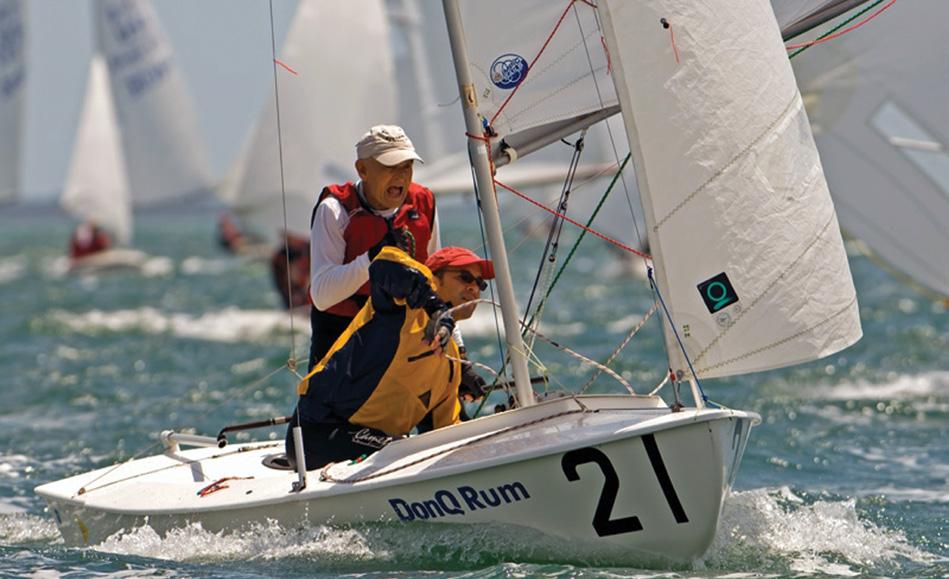
Good sailing results are nice. But what really makes a life is how you live it. Here are some lessons I have learned from his life well lived on things that are really important:
Respect for others and awareness that we’re all here together. A simple thing, but an example of helping each other out. The docks at Coconut Grove Sailing Center in Miami, FL, where many Snipe regattas are held, are fantastic but not super big. We need to work together to get so many boats in the water for racing. It’s not possible for everyone to put their boat in the water, leave their boats to go finish getting dressed, and then go sailing. So, we chide those who don’t follow the Old Man Rule: “Don’t put your boat in the water unless you are ready to go sailing.”
Old Man enjoyed talking about his dear friend Dr. Inclan. One story was from back in the days where there were no penalty turns—if you fouled, you were simply out of the race. One day, Dr. Inclan was racing, rounded a mark, and then headed into shore. Asked why he had come in, Dr. Inclan explained that he had hit the mark, and the penalty was to withdraw from the race. “Did anyone see you?” he was asked. No, but it was the right thing to do, so that’s what Dr. Inclan had done. Old Man lived and sailed this way, too.
Giving back to the sport you love. In addition to his time on the international Snipe Board and as Commodore of the Snipe Class International Racing Association, Old Man served as fleet captain,
regatta chair, party host, provider of space for boats between regattas, cheerleader for young sailors, and ultimate champion for Snipe sailing. Supporting new sailors.
Old Man, in collaboration with his family and more recently other members of the Miami Snipe Fleet, has been so very generous with enabling new sailors to try the Snipe for regattas. The concept of the “fleet loaner boat” likely originated with him. I can only
imagine that at least several hundred sailors (literally) first stepped into a Snipe thanks to his efforts. For most of these people, sailing—whether in Snipes or other boats—“stuck.” They are now sailors for life. Talk about growing our sport!

Cherishing history, celebrating traditions. For many years, the highlight of the Comodoro Rosco Regatta (which honors the longtime commodore of Havana’s Miramar Yacht Club) was Saturday
evening dinner at Old Man and his wife Carmen’s home. After stuffing ourselves with way too much lasagna and fantastic Cuban desserts, sailors were treated to old family videos of sailing Snipes in Cuba, narrated by the Old Man. These gatherings were extra special because often there were multiple generations of Snipe families together in the same room, celebrating and learning about the history that underpins the Snipe class. Celebrating the regatta winners the next day through a communal singing adventure (and a bit of punch drinking) is another part of Snipe class heritage. And that’s only one weekend of Old Man-established traditions— there are many more!
Valuing family.
Yes, Snipe sailing was a huge part of his life. But far and away, tops, above it all, no questions asked—his family was everything. He and Carmen were together for almost 80 years (and as you might imagine, Carmen is an absolutely wonderful, kind, and lovely woman). Their dynamic family grew to include three children and eight grandchildren and eight greatgrandchildren.
Living (and sailing) with joy. No real words for this one; just check out thie photo on page 87 by Fried Elliott from the 2006 Snipe DonQ Regatta and try not to smile. I’ll bet you can’t do it. Old Man and crew Greg Saldana are kicking butt downwind (as you can see from the bunch of boats trying to catch up with them). As you can tell from the expression on Old Man’s face, it’s a fantastic day for sailing on Biscayne Bay! #
About the author: SpinSheet Small Boat columnist for more than a dozen years, Kim Couranz has earned several national and world titles in Laser Radials (ILCA 6) and Snipes. She has also raced J/22s, J/24s, and Ynglings on an international level.
Rick and Valerie Smith of Smith’s Marina in Crownsville, MD, shared this news with their customers. “Our family has been honored to provide marine services to you and our many friends and neighbors over the years. After much reflection, we have come to the conclusion that we need to play more and work less. So, effective March 1st, we are retiring! Smith’s Marina has been in our family for three generations. It is part of the fabric of our local community. We have chosen to sell Smith’s Marina on the Severn to two local families, the Conroys and the Sullivans. Apart from the ownership, nothing will change. Larra and Lindsey will still be in the office ensuring you get the best possible service. Our yard staff remain and are dedicated to servicing all your maintenance, repair, and storage needs. And you will likely still see Rick around the marina working on boats, but he will finally have the time to work on his own! The Conroys and the Sullivans have been long-time customers and friends. They know the marine industry inside out as lifelong boaters and industry insiders with decades of experience. We are confident we are passing the torch to two local families who will continue the legacy that was begun by Rick’s grandfather, Alonzo Smith, back in 1936. Thanks for supporting our family all these many years. We aren’t going anywhere. We are just freeing up some time to play more. We look forward to seeing you all on the water.” smithsmarina.com
At the Miami International Boat Show in February, Italia Yachts announced its first powerboat project, the IY43 Veloce, which opens a new era for the 12-year-old shipyard. The announcement is happening just months before production begins at the new shipyard in Fano, central Italy. The new Italia Yachts 43 Veloce is part of a rather crowded but exciting range. “We developed the model on a hybrid concept between a pure walkaround and a day cruiser, which is why the interior also has generous space and class-leading headroom. The lines, in general, mimic those of the well-established range of sailboats from Italia Yachts…” says Sebastien Nolasco, general manager of Italia Yachts. Erik Haaland, sales director of Italia Yachts USA and David Walters Yachts, added, “The launch of the IY 43 Veloce is the result of a collaboration between us in the Americas and the Italia Yachts shipyard, creating a yacht that is truly able to be recognized and used in Europe and the US. The hull design, interior layouts, systems engineering, amenities, and the choice of Volvo IPS or Mercury outboard propulsion will cater to many of the needs of US boaters. We are confident of the market response and prepared to serve all major yachting areas. For more details, email erik@davidwaltersyachts.com
Coastal Conservation Association Maryland and partners announce a second season of “Chesapeake Perspective:” three, live-streamed roundtable events featuring leading experts from the Chesapeake and Atlantic region who will engage in entertaining and thoughtprovoking conversations designed to spark innovative and real solutions to some of the most pressing issues confronting Chesapeake recreational anglers today, tomorrow, and in the years to come. Chesapeake Perspective is presented in partnership by the Coastal Conservation Association Maryland, American Sportfishing Association, BoatUS, Congressional Sportsmen’s Foundation, Yamahas Rightwaters, Theodore Roosevelt Conservation Partnership, and the Marine Trades Association of Maryland. The moderator is Lenny Rudow, FishTalk magazine’s Angler-in-Chief. The events take place the third Thursday in April, June, and September from 7 to 8:30 p.m. Topics include: April 20 –Opportunities and Impacts of Invasive Fish, June 15 – Expanding Angler Access, and September 21 – Habitat Preservation and Restoration. CCA Maryland executive director David Sikorski issued the following statement: “Now more than ever, it’s crucial that we implement effective solutions that begin to address some of the most pressing issues confronting Chesapeake recreational anglers. Our Chesapeake Perspective series is a step forward in that effort…” Join the conversation during the live streaming. Register today for free at fishtalkmag.com/chesapeake-perspective
The National Marine Representatives Association (NMRA) welcomes its new officers and board of directors. Taking the helm as NMRA president is Aaron Freeman of Tideline Marketing. Joining Aaron on the Bridge is Mark Goodman, vice president (SGL Sales and Marketing), Craig Cochran, secretary (GSW and Associates), and Mike Steiner, treasurer (West Coast Sales). The NMRA Board of Directors includes returning board members Rob Guerrieri (Atlantic Marketing Company) and Kurt Fromherz (Waters and David Company). Joining Rob and Kurt on the NMRA Board are Jack Groseclose (North Pacific Marketing), Chris Martorana (The Merifield Company), Nick Gove (Midwest Outdoor Marketing), and Jim Cermak (Thundercat Marketing). nmraonline.org
AkzoNobel is marking the 50th anniversary of its world renowned Awlgrip brand with activities throughout the year to celebrate. Awlgrip originated out of an Aerospace coating, Alumigrip, in 1973. Over the five decades since its inception, the Awlgrip range has expanded to encompass finishes, primers, fillers, and varnishes, becoming a world-class brand that can be found in almost every port and country around the globe. Its superlative finish has seen it earn the truly unique accolade of becoming a verb, with proud customers referring to having their boats ‘Awlgripped.’ “To reach this milestone is a real testament to the dedication, professionalism, and passion of all applicators and boatyards who have devotedly applied Awlgrip products on boats of all sizes and helped shape the brand over the last fifty years,” says Jemma Lampkin, global commercial director at AkzoNobel Yacht Coatings. “As a result, we wanted to take a moment to highlight these achievements and pay tribute to all those who have made and continue to make Awlgrip what it is today and tomorrow. We are excited to showcase all the passion that Awlgrip applicators, boatyards, and owners share when they look at the boat with that amazing finish that Awlgrip continues to deliver.” awlgrip.com
Help a Wounded Veteran 240-750-9899


BOATs4HEROEs.ORg
S&J Yachts, Brokers for Fine Yachts



With 10 locations from Maine to Florida, S&J Yachts is one of the largest full-service yacht brokerages on the East Coast. Our extensive reach & marketing helps find top buyers quickly. S&J Yachts has established an outstanding reputation for integrity and service! Our experienced team of brokers is committed to serving both buyers and sellers, ensuring fair practices and complete satisfaction with every deal. Whether sail or power, we’ll help you find the perfect fit! 410.639.2777 info@sjyachts.com www.sjyachts.com
Yacht View Brokerage, LLC announces our new 8% commission, which may include complimentary Annapolis dockage (for yachts above 100K and up to 80’ in length) and 10% co-brokerage listing commission! We will successfully market your yacht from her current East Coast location or arrange delivery to our secure dockage for yachts from 30’-80’ (Power/Sail). Located 20 minutes from BWI airport, our listings are easily inspected and demonstrated to prospective buyers. Targeted print advertising & Yachtworld.com MLS internet exposure with wide angle/high resolution photos and video. 30 yrs proven customer service! Call/text Capt. John Kaiser, Jr. @ 443.223.7864. Email your yacht’s details for a full market appraisal to: john@yachtview.com www.yachtview.com
8’ Fatty knees Sail/Rowing Dinghy Lap strake fiberglass hull, teak trim, center board, folding rudder, mast w/ wood boom, new sail (2021). New lines, new 6’ oars. Trailer: new bearings + tires (2022), needs title. $2,750 Call 443.370.3429 or email wpsheils@gmail.com www.fattyknees.com/specifications.html



Looking for an upgrade? Spring is the best time to sell your boat, especially in this fast-paced market. Mike Coe at North Point Yacht Sales is an experienced yacht broker who brings outstanding service and dedication to each client. With Mike’s 15 years of experience working as a broker, sailmaker and boatbuilder’s factory representative, he brings technical expertise and broad market reach to each listing. To list your boat, contact Mike today at 410.387-8859 or Mike@ NorthPointYachtSales.com www.NorthPointYachtSales.com
Deanna Sansbury developed her love of the water when she and her husband lived aboard their 40’ catamaran, eventually taking a sabbatical to cruise the Islands. Upon returning, she began selling sailboats for a large brokerage in Annapolis, winning the Beneteau Top Gun award for most new sailboats sold in North America. By focusing on providing exceptional customer service and listening closely to her clients’ needs, she is a top pick for buyers and sellers looking for outstanding results. Cell: 410.629.9186
Deanna@YachtBrokersofAnnapolis.com www.YachtBrokersofAnnapolis.com


YaZu Yachting YaZu Yachting is delighted to welcome Arabella Denvir to the team in Deltaville, VA. Arabella grew up in a sailing and boatbuilding family in Kinsale, Ireland. She has shared her passion for sailing over the past 30 years through teaching; she has owned & run sailing schools in Malta and Virginia. Arabella has always enjoyed sharing her love of sailing and helping people find the right boat, fulfilling their small boat sailing dreams. In joining YaZu Yachting as a broker, Arabella can now extend this activity to bigger boats and bigger dreams! 804.815.0150 arabella@yazuyachting.com www.yazuyachting.com

8’ Fatty knees Dinghy Trailer. Cover. Only used 4 times. $4,000 Chestertown, MD. 207.266.5493 or flaxhermes@yahoo.com
30’ Bristol Sailboat Partnership on South River Two weekend and five weekdays each month, May - October. Spring / Fall maintenance days. $2,200 Call John: 202.341.4483 / jruthrauff@democraticed.org

Sailboat Partnership Available 1983 Hunter 34 partnership looking for new member. Sails great and roomy for its size. Fully equipped. Great value at $3,000 buy-in, $750 annually. Contact Floyd 443.454.8210

























1981 Cape Dory '33 TURNKEY CONDITION. Immaculately clean refurbished interior. New engine 2022. Updated in 2018: Propane stove, battery charger, auto helm, depth finder, VHF, faucets/freshwater pump, mainsail, standing and running rigging, all canvas. Jib replaced 2020. $45,000 Call 410.200.6157
1985 Catalina 27 Exceptional condition. Fresh water boat, winter dry storage, 2nd owner since 1994. Fin Keel, Standard Rig, 18Hp Universal diesel, Pedestal w/ wheel and instruments, Autopilot, Bimini, Harken roller furling, Mainsail and 150 headsail good condition, Tabernacle mast raising system, Custom teak cabinets, Newer interior and cockpit cushions, 1999 Triad float off trailer. $27,500 Call 570.650.1717 or email philippsauto@comcast.net
35’ Chris Craft “Sail Yacht” Classic Sparkman Stephens design, fiberglass hull built by Chris Craft in Michigan. Kubota diesel, Isotherm refrigeration, new head. Featured in Good Old Boat, May 2015. Located in Virginia. $32,500 410.490.1191 studioda35@gmail.com
34’ Jeanneau 349 ‘23 Model Year #841 IN STOCK! Limited edition, Performance pack, Sails fantastic, A true performance cruiser, Great for the bay! Call today to schedule a showing/ Demo sail. 410.269.0939 or www.CrusaderYachts.com

40’ Pacific Seacraft 40 Beautifully equipped & maintained, ready for next offshore adventure! Great maintenance & upgrades. Asking $275,000 Call Rod Rowan 703.593.7531 today! www.CrusaderYachts.com
41’ Jeanneau Sun Odyssey 410 ‘23 Hull #242 IN STOCK! Very wellequipped! Call your Favorite CYS broker today for more info! Available now for Spring delivery! 410.269.0939 or www.CrusaderYachts.com
1978 Bristol 29.9 Well-maintained, nice wood interior with lots of headroom. Lewmar 40ST winches, Yanmar diesel, h/c water, wheel, bimini. Located in Urbanna, VA. Don Pringle 804.776.8400. $18,700

(Bon Chance) 29’ Paceship Chance ‘74
Lively, actively sailed and well-loved cruiser/racer. Dependable Atomic 4 engine, new exhaust, newly replaced windows, Harken roller furling. Early April launch, ready to sail! $8,900 Call 443.822.4096 or artholtjr@gmail.com
Catalina 30 '90 1990 Catalina 30 Tall Rig, Wing Keel. Free slip until spring at current owner’s private dock. Virginia, lower Potomac. New main. Cream color hull. MX25 engine. $19,000 703.963.8611

32’ Allied Seawind ketch ‘76 Five sails, 30Hp Yanmar, C&G stove and oven, depth and speed log, 2 chart plotters. $19,500 Mike 410.446.7258


(Jangada) 35’ Hunter Legend ‘90 Solar. Wood stove.
Well-
Freshly painted hull. Ready to sail! $38,700 Located in Pasadena, MD. Call Dave at 240.285.4016 www.jangada.info



37’ Excess 11 ‘23 Model Year, Boat of the YEAR winner! This new catamaran has won awards around the worldCome see what it’s all about! 37-foot Performance cruiser! Hull #75 IN STOCK 410.269.0939 or www.CrusaderYachts.com
44’ Jeanneau 44DS ‘14 3 Cabin, 2 Head layout on this late model Beauty! Thruster, Watermaker, Solar, Low hours, lightly cruised. Dink and Davits are SOME highlights! Asking $295,000 REDUCED, won’t last long! Call Rod Rowan 703.593.7531 or www.CrusaderYachts.com
1979 Gulfstar 37 For Sale By Third Owner Year-old 125% headsail, Hood-808SL furler on 3/8” forestay. Two-year-old mainsail, new stackpack and lazy jacks. New self-tailing, Lewmar#46 main winches. LofransRoyal-Horizontal-Manual Windlass. 44#Bruce and 20#Danforth anchors. Dodger, full Bimini over cockpit. Price negotiable, dependent if desired as a bare boat or fully equipped cruiser: $40,000 to $50,000 USD. Details link below or contact owner: John Maliszewski 410.353.8115(M) or jrmalis@verizon.net


https://bit.ly/3xAgTHE
Sabre 38' Mark 1 Divorce sale. $10,000 Boat needs work. Sails included. Make this boat your winter project! Call 410.703.5699 or email 21401naptown@gmail.com
38’ Sabre 386 ‘04 Quality build midsize cruiser. Cruise Equipped, Air, Solar, Updated Electronics and moreNew Main. Asking $215,000 Call Dan Bacot 757.813.0460 or www.CrusaderYachts.com
46’ Jeanneau Sun Odyssey 469 ‘13 Lightly used on Chesapeake only, 3 Cabin, 2 Head layout, Genset, Electric Halyard and Primary Winches, Raymarine Electronics and more. REDUCED! $319,000 Call Dave van den Arend 443.850.4197 or www.CrusaderYachts.com
39’ Excess 12 ‘22 Another Excess Boat of Year Winner! Cruise Ready Excess 12 #29 is ready for delivery NOW! Call CYS offices and speak with your favorite Broker! $650,000 410.269.0939 or www.CrusaderYachts.com
To find more used boats, visit spinsheet.com
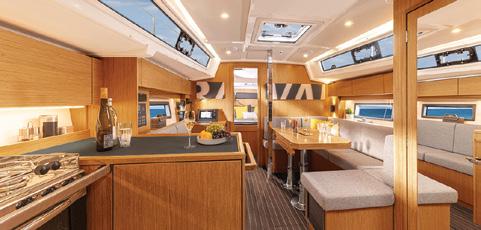



49’ Excess Catamaran 15 ‘23 Pulse Line Rigged. Loaded with cruising gear and elegance not yet seen in family cruising cats! Hull #14 IN STOCK!! Deposit NOW - Close/Deliver Spring 2023! Call your favorite CYS Broker for more info! 410.269.0939 or www.CrusaderYachts.com
409 Chester Avenue, Suite A Annapolis, MD 21403
1.855.266.5676 | info@curtisstokes.net www.curtisstokes.net
(Confidante) 36’ Vancouver ‘82 $60,000 Floyd White 252.764.1222 floyd@curtisstokes.net www.curtisstokes.net
(Chaucer Blue) 41’ Morgan ‘77 $40,000 Lars Bergstrom 910.899.7941 lars@curtisstokes.net www.curtisstokes.net
49’ Jeanneau Sun Odyssey 490 ‘23


Performance Cruiser, Furling mast, Air, Gen, Thruster, and more, ready to go cruising! Hull #168 IN STOCK!! Deposit NOW - Close/Deliver Spring 2023! Call today to schedule a showing with your favorite CYS Broker 410.269.0939 or www.CrusaderYachts.com
(Sojourn) 30’ Baba ‘85 $59,500 Tristan Weiser 609.420.0469 tristan@curtisstokes.net www.curtisstokes.net
(Zephyrus) 37’ Irwin ‘74 $19,000 Floyd White 252.764.1222 floyd@curtisstokes.net www.curtisstokes.net
(N2Deep) 42’ Catalina ‘03 $165,000 Joe Evans 843.813.8324 jevans@curtisstokes.net www.curtisstokes.net
51’ Jeanneau Sun Odyssey 519 ‘17
Great equipment list on this late model Jeanneau. All set for coastal or offshore cruising. Blue Hull, Davits, Genset, Thruster, Air Con, Water Maker, Solar and more! 3 Cabin, 2 head layout. Price reduced, asking $395,000 Call Gordon Bennett 410.739.4432 or www.CrusaderYachts.com
(Wimsey) 34’ Tartan ‘88 $38,000 David Robinson 410.310.8855 david@curtisstokes.net www.curtisstokes.net
(Native) 38’ Herreshoff ‘70 $29,900 Lin Earley 757.672.2778 lin@curtisstokes.net www.curtisstokes.net


(Chanticleer) 42’ Endeavour ‘89
www.curtisstokes.net
(kalena) 38’ Hunter ‘03 Curtis Stokes 410.919.4900 curtis@curtisstokes.net www.curtisstokes.net
Leave 10% Brokerage Fees in Your Wake Jay Porterfield • Knot 10 Sail (410) 977-9460 • jay@knot10.com
2001 Lagoon 380 3-stateroom owner version. Generator, ac/heat. Call Jay 410.977.9460 jay@knot10.com www.knot10.com

43' Jouet 1280 Most well-designed motor sailor I have ever seen! Perfect condition. This is a must see! Visit Knot10.com and look at her! Call Jay 410.977.9460 jay@knot10.com www.knot10.com






66’ CNB 66 ‘21
Well-equipped for off-shore/distance cruising comfort. 4 cabins/4 heads with Captain/Crew cabin in bow. Asking $2,550,000 Call Mike Titgemeyer 410.703.7986 or www.CrusaderYachts.com
www.curtisstokes.net
(Skyfall) 39’ Beneteau 393 ‘03 $120,000 Jason Hinsch 410.507.1259 jason@curtisstokes.net www.curtisstokes.net


2005 Jeanneau Sun Odyssey 54 DS Captain’s layout. Full B&G Yacht Electronics. Call Jay 410.977.9460 jay@knot10.com www.knot10.com
To find more sailboat listings and boat reviews, visit spinsheet.com




2020 Dehler 30 One Design Without question, the most innovative production level boat to come on the market in some time. Contact David Malkin at 410.280.2038 or David@NorthPointYachtSales.com www.NorthPointYachtSales.com
2003 J Boats J/109 A proven winner with Full Range of North Sails, B&G Electronics, Polars and Sail Charts. Contact Bob Oberg at 410.280.2038 or Bob@NorthPointYachtSales.com www.NorthPointYachtSales.com
1995 Sabre 362 A great sailing yacht, well-maintained and upgraded. Contact Bob Oberg at 410.280.2038 or Bob@NorthPointYachtSales.com www.NorthPointYachtSales.com

1996 Dehler 37CR Well-maintained and ready to sail away for a coastal cruise. Contact David Malkin at 410.280.2038 or David@NorthPointYachtSales.com www.NorthPointYachtSales.com
1994 Hunter 37.5 Perfect for the casual sailor and has been lovingly cared for by the current owner. Contact David Cox at 410.280.2038 or DavidCox@NorthPointYachtSales.com www.NorthPointYachtSales.com
2016 Hanse 415 Very nice performance cruiser, well-equipped with spacious accommodations. Contact Chris Beardsley at 804.885.4090 or Chris@NorthPointYachtSales.com www.NorthPointYachtSales.com
1977 Baltic 42 Newly finished restoration project. Whether racing or high-performance cruising, she is a must see! Contact Mike Coe at 410.387.8859 or Mike@NorthPointYachtSales.com www.NorthPointYachtSales.com
2013 Dufour 45E Performance racer/ cruiser. Nicest, most well-equipped 45E you will ever find. Single owner and professionally maintained since new. Contact David Malkin at 410.280.2038 or David@NorthPointYachtSales.com www.NorthPointYachtSales.com
1985 Pearson 530 Rare opportunity for an excellent blue water cruise; Several upgrades and meticulous maintenance. Contact Chris Beardsley at 804.885.4090 or Chris@NorthPointYachtSales.com www.NorthPointYachtSales.com
2001 J Boats J/145 Turnkey example of one of the best J Boat designs. Vast list of new upgrades on this unique and sought after boat. Contact Grady Byus at 410.280.2038 or Grady@NorthPointYachtSales.com www.NorthPointYachtSales.com
Annapolis, MD 410-571-3605
Rock Hall, MD 410-639-2777



Deltaville, VA 804-776-0604

Charleston, SC 843-872-8080
Palmetto, FL 941-212-6121
www.SJYACHTS.com

Island Packet Yachts 27’-52’

Island Packet with the Experts! S&J Yachts is the World leader in selling IPs. No team knows these boats better! We have buyers looking now for these excellent cruising yachts. Call S&J now for a free market evaluation. 410.639.2777 www.sjyachts.com

Pacific Seacraft 31 ‘19 Nearly new, well-equipped w/ optional equipment, incl. cutter rig, shoal draft keel (4”), bow thruster, anchor windlass, inverter/ charger, reverse cycle AC/heat, and custom hard top dodger. $298,000 S&J Yachts 410.639.2777 www.sjyachts.com
To find more used boats, visit spinsheet.com

35’
355 ‘14 Nicely equipped & very well kept. 2 spacious cabins, 1 head, AC, solar, in-mast mainsail furling, AIS (transmit & receive), dinghy & outboard, professionally installed lithium batteries w/ new wiring & invertor/charger. $205,000 S&J Yachts 410.639.2777 www.sjyachts.com
speed, safety and maneuverability. $135,000 S&J
410.639.2777 www.sjyachts.com
Custom Islander 56 ‘92 Equipped for your adventures! Lloyd’s construction, sailplan options deliver safe, efficient passage-making. Belowdecks, warm, rich cabinetry & luxurious fabrics create elegant social areas. Generous storage. Secure accommodations. Reduced $299,000 S&J Yachts 410.639.2777
Anne & Jon Hutchings
Southerly Yachts 37’-57’ NEW & Brokerage. Best shoal draft, bluewater boats for over 40 yrs. Sail the Bay or cross Oceans. Push button variable draft swing keel completely retracts inside hull. Several brokerage boats available: 37’, 42’, and 57’. S&J Yachts 410.639.2777 www.sjyachts.com

410.639.2777 www.sjyachts.com
17218 General Puller Hwy, Deltaville, VA Anne: 804-567-0092 | Jon: 804-567-0093 www.yazuyachting.com


41’ Tartan 41 ‘74 Sparkman & Stephens design - sporty, sailing machine w/ flush deck! Spacious below, very well maintained. Standing Rigging 2016, 37Hp Beta Marine engine & Autostream Prop, new mainsail 2018. $49,000 Deltaville, VA. Call Jon Hutchings 804.567.0093 or jon@yazuyachting.com www.yazuyachting.com






Moody 38 Well-equipped and ready to cruise. Bow Thruster, Roller Fulling Boom, Arch, Dingy, New Electronics, New Sails & Full Enclosure Canvas, Much More. $220,000 S&J Yachts 410.639.2777 www.sjyachts.com
S&J Yachts 410.639.2777 www.sjyachts.com
40’ Norseman 400 ‘87 This much sought after boat gives great sailing in both light and heavy airs. New rigging 2016. Spacious interior. Deltaville, VA. $75,000 Call Arabella Denvir 804.815.0150 arabella@yazuyachting.com www.yazuyachting.com
of recent upgrades! Rod rigging 2020, new sails 2022, B&G instruments 2019, new stove & fridge 2019, MaxProp solar, & lots more. $138,000 Deltaville, VA. Bob Hoefer 804.241.8924 bob@yazuyachting.com www.yazuyachting.com
or
Cabin/3 head Layout. Tall rig, Shoal draft, Genset, Watermaker, Wind Generator, Davits, Electric heads, New refrig (2022), Dinghy & outboard. $249,000 Hayes, VA. Call Jon Hutchings 804.567.0093 or jon@yazuyachting.com www.yazuyachting.com
S&J Yachts 410.639.2777 www.sjyachts.com
S&J Yachts 410.639.2777 www.sjyachts.com
41’ Fountaine Pajot Lipari ‘13 4-Cabin, 2-Head. 220V/12V. Never Chartered. Solar, Volvo 30Hp (upgrade), Flexofold prop, ROCNA 33KG, Anchor Camera, Asymm Spinnaker, Davits, Liferaft, Garmin instruments, Dinghy & Outboard. $345,000 Mathews, VA. Call Anne Hutchings 804.567.0092 or anne@yazuyachting.com www.yazuyachting.com
47’
until 2019, cruised 2019/20. 2 Cabin, 2 head. Updated Raymarine electronics, washer/dryer, aircon, 5’10” draft. $176,000 Deltaville, VA. Call Anne Hutchings 804.567.0092 or anne@yazuyachting.com www.yazuyachting.com
To find more sailboat listings and boat reviews, visit spinsheet.com

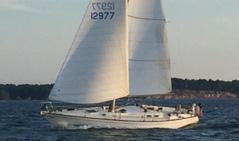





1” Solid Back Stainless-Steel Rub Rail 100’Nice drilled 6” spacing. Can deliver up to 100-mile radius from Annapolis. $4,000 Call 561.281.5307
Seaside Treasures Shop for nautical decor, beach decor, and more for your lake cottage or beach home! A family run business since 2001. Use coupon “SPINSHEET10” for 10% off! ContactUs@SeasideTreasures.com www.SeasideTreasures.com
Offshore Passage Opportunities Your Offshore Sailing Network. Celebrating twenty years helping sailors sail offshore for free. Learn by doing. Gain Quality Sea Time! Call 800.4.PASSAGe (800.472.7724). Keep the Dream Alive for the Price of a Good Winch Handle! Since 1993. admin@sailopo.com www.sailopo.com





Endurance Yacht Deliveries Local and long distance. Twenty-five years of experience with clean insurance approved resume. Power and sail. Please call Simon Edwards 410.212.9579 or email stredwards@gmail.com www.enduranceyachtdeliveries.com
Canvas Department Manager - Quantum Sails
We are looking for an experienced Canvas Fabricator to join our ever-growing team in the heart of Eastport. Excellent pay, with benefits. Email your interest to resumes@quantumsails.com www.quantumsails.com
Captain Wanted - Baltimore’s Inner Harbor Weekends and charters during the week. Our boat is an 86 passenger Pirate boat, twin diesel powered. Flexible hours and competitive pay. Go to urbanpirates.com and apply via the Crew Wanted link under Contact Us. admin@urbanpirates.com www.urbanpirates.com/baltimore_crewwanted.html

Dock Hand/Dock Staff FT & PT April-October. Hourly pay plus tips $$ to tie-up boats located at a busy dock bar location in Annapolis. Boating knowledge is a plus. 410.263.1981 Download application at www.schoonerwoodwind.com/employment/


Electronic Marine Annapolis is looking for a Full- or Part-Time installation technician and an installation assistant to install and service marine electronic and electrical systems on boats. Prior boat maintenance experience preferred. Our Full Time Tech’s work Monday to Thursday, 10-hour days. Pay and benefits based on experience. Our office is located at Bert Jabin Yacht Yard in Annapolis. Please email your resume to Sales@ElectronicMarine.com




Electronic Marine Annapolis is looking for a Full- or Part-Time Sales/Office Manager or Assistant. Duties include meeting with customers, scheduling projects, boat shows, preparing invoices and estimates. Prior QuickBooks and boating experience preferred. Office hours are Monday to Friday, 8:30 AM to 5 PM. Pay and benefits based on experience. Our office is located at Bert Jabin Yacht Yard in Annapolis. Please email your resume to Sales@ElectronicMarine.com
Get Paid to Sail! The Woodwind schooners are hiring crew/deckhands. Some sailing knowledge is necessary. Fun people and guests - avg. $27/hour, and lots of great sea time. FT & PT. 410.263.1981 Download application at www.schoonerwoodwind.com/employment/
Gibson Island, MD - Boat Works - Full Time Jobs We seek several skilled marine technicians and yard staff to diagnose system issues, perform seasonal maintenance, lead repair and restoration projects: varnishing, carpentry, woodworking, or to operate the Travelift. M-F 8am-4:30pm. Benefits: medical, dental, vision, life, STD, FSA, HRA, 11 paid holidays plus vacation & sick time. Join a professional crew of 20! Contact Boat Works: 410.255.8777. Submit resume to: jobs@gibsonisland.com

Marine Mechanic, Port Annapolis - Port Annapolis Marina is hiring marine diesel mechanics. Must have a strong work ethic, require minimum supervision and at least 2 years of experience on power and/or sail. Knowledge of outboards, outdrives, and sail drives is a plus. Salary commensurate with experience. Our benefits package includes vacation days, health insurance, 401K, profit sharing, and incentive bonuses. Send resume to richard@portannapolis.com www.portannapolis.com
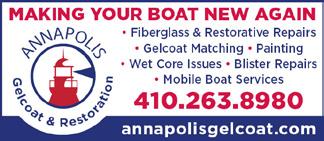

P/T Delivery Driver - Baltimore City for three-day-amonth magazine distribution route in Baltimore City & surrounding area. Compensation based upon quantity of stops. Must have a valid driver’s license in good standing, reliable vehicle, and be able to lift up to 25 lbs. Contact Beatrice at 410.216.9309 or beatrice@spf-360.com

The Eastport Yacht Club (EYC) is hiring Head, Lead, and Assistant Sailing Instructors for the 2023 Summer Program. Please send your cover letter and resume to the Waterfront Manager at waterfront@eastportyc.org
Yacht Sales - Curtis Stokes and Associates, Inc. is hiring new salespeople for our Chesapeake area operation. Candidates must be honest, ethical and have boating experience. This is a commission only position. Contact Curtis Stokes at 410.919.4900 or curtis@curtisstokes.net www.curtisstokes.net

For Sale: Suzuki 9.9 Outboard Still in break-in period. $1,300 Call Richard: 443.618.6469 or email rjoklik@gmail.com
Your CNG tanks empty? Been searching far and wide for refills? Considering an expensive conversion? Worry no more, your local refill connection is waiting and eager to help! Call 410.279.7322 or email peterholzinger4@gmail.com









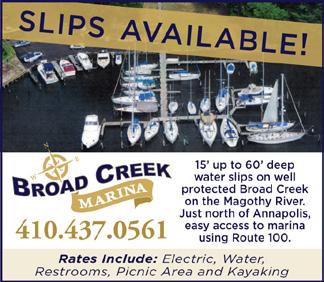


30’-50’ Deepwater Slips for Sale & Rent Flag Harbor Condo Marina on western shore of Chesapeake in St. Leonard, MD. Slip sales & rentals 410.586.0070/ fhca@flagharbor.com Storage & Repairs 410.586.1915/ flagboatyard@gmail.com www.flagharbor.com


34’ Slip for Sale on Spa Creek - at the end of Burnside Street in Eastport. Swimming Pool, clubhouse, parking included! $48,000 OBO Call or text 717.554.8432
For Rent or Sale: Magothy River Boat Slip Boat slip for sale or rent in beautiful condo marina in Severna Park on Magothy River. Gated, pool, complete bathroom, laundry facilities, fuel dock. 26’ x 12’ deep water. Call Holly 301.325.7247
Galesville – West River Deep Water Slips with water and electric, 20 to 40 feet. $1,200 to $3,500 per year. 410.212.4867
Sailor’s Wharf Marina on Mill Creek off White Hall Bay, 20-to-45-foot slips with water & 30-amp electric. 1651 Orchard Beach Road, Annapolis, MD 21409. For more information, please call 443.336.3615 or email sailorswharfmarina@gmail.com


P/T Delivery Driver Wanted for three-day-a-month magazine distribution route Baltimore city. Compensation based upon quantity of stops. Must have a valid driver’s license in good standing, reliable vehicle, and be able to lift up to 25 lbs. Contact Beatrice at 410.216.9309 or beatrice@spf-360.com
Find all the latest listings online at spinsheet.com



If you complete this puzzle, take a photo of it, and send it to editor@spinsheet.com. We will send a SpinSheet hat to the first reader to submit the correct answers.
ACROSS
1 Sound it makes when it hits you
3. Used to catch a fish?
4. 30 _____ shore power
8. Creek in Annapolis
9. Opposite of WSW
11. These make the boat go
14. Steer towards one, perhaps?
16. A hearty hot meal aboard
17. Royal Southern Bay river
20. Opposite of starboard
22. River flowing through Fredericksburg
24. SpinSheet readers might have one
25. River at the top of the Bay, abbrev.
26. Bay river flowing through Harrisburg, PA
28. Classifieds listing boats for sale
31. Cambridge port river
35. Opposite of port, for short
37. “Land ___!”
38. 2000 pounds
39. Tasty desserts onboard
41. ____ rail, or something not to stub
44. Rocking ____ and fro
45. Tasty frozen drink for young sailors
46. River between West and Severn
48. Sailmaker every compass points to
50. Mount Gay logo often seen on one
51. Female deer
54. Often how to repair a sail
55. Ships usually keep inside this
56. Where you sail to when not near
58. A tide that’s going out
60. Ginger dark ‘n stormy ingredient
62. Often played at a flag lowering
63. Used to steer small sailboats
1. The Chesapeake is one
2. Crew, to a solo sailor
3. Opposite of SW
4. The “A’s” in ASAP
5. Sloops have only one
6. A place for halyard crew
7. Opposite of ENE
8. Tolley Point light is at its mouth
10. Where anchor lights are on a mast
12. Has right of way vs. windward
13. Star Spangled Banner river
15. River, or a peppermint patty?
18. When you’ll get there
19. SPF 50 protects from this
21. Wind angle when close hauled
23. Fawcett’s Friday Night Beer___ Racing
24. I’d rather __ sailing!
25. Southern Bay river with rum perhaps?
27. Coup d’ _____
29. Docking lines to secure back of the boat
30. Spin often goes through it for takedowns
31. River near Washington College
32. Santa says this three times
33. To be or __ to be?
34. Unit of boat speed or a bowline?
35. ___ Sheet Magazine
36. Fawcett’s Friday Night __ Can Racing
40. The skipper ___ the boat’s heading
42. These turn the boat
43. A boat’s traditional gender
47. We all love __ go sailing!
49. Railmeat helps reduce this
52. Spin __ Magazine
53. Do this when praying for wind, perhaps?
57. Captain’s berth is often ___
59. These docking lines secure the front
61. River named for an antlered mammal
1. I will commit to making sailing better for everyone.

2. I will mentor young sailors and help them gain access to big boat sailing.
3. I will help people in the boat park and on the dock.
4. I will welcome new boat owners to the fleet, introduce them to other owners, and help them learn the fleet culture and how to make their new boats go better.
5. I will learn the racing rules of sailing.
6. I will put safety first and wear my lifejacket when I should.
7. I will make time to connect with anyone I got into it on the racecourse with and shake their hand, buy them a beer, etc. Even if we are headed for the room, I will remember we are all out there for the same thing—to have fun—and that we just saw things differently.
8. I will thank the race committee, volunteers and sponsors and will go to the regatta party to interact with them and other sailors.
9. I will fly the EWE flag (or sport other EWE gear) to show that I sail like EWE did, and I will always be watching, ready to catch others sailing like EWE did. When I do, I’ll thank them.

10. I will support the mission of the EWE Spirit Foundation on and off the water.


11. I will not forget how lucky I am to be able to sail like EWE did.

Already dreaming about a cruising adventure or big race for this season? Scan the QR code to schedule service or to contact a representative for assistance with new sails. We’re here to do whatever it takes to get you on the water and keep you sailing.

